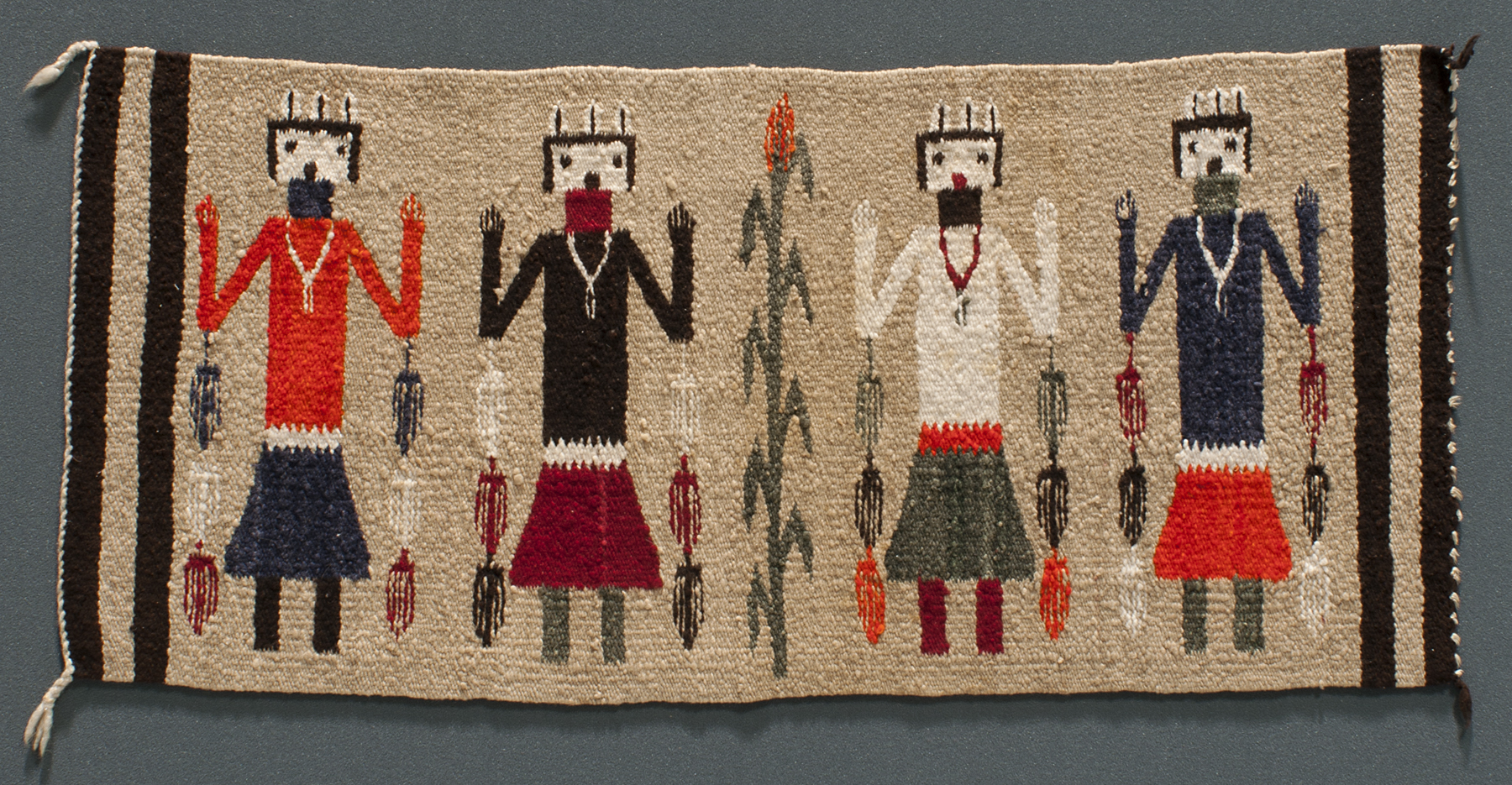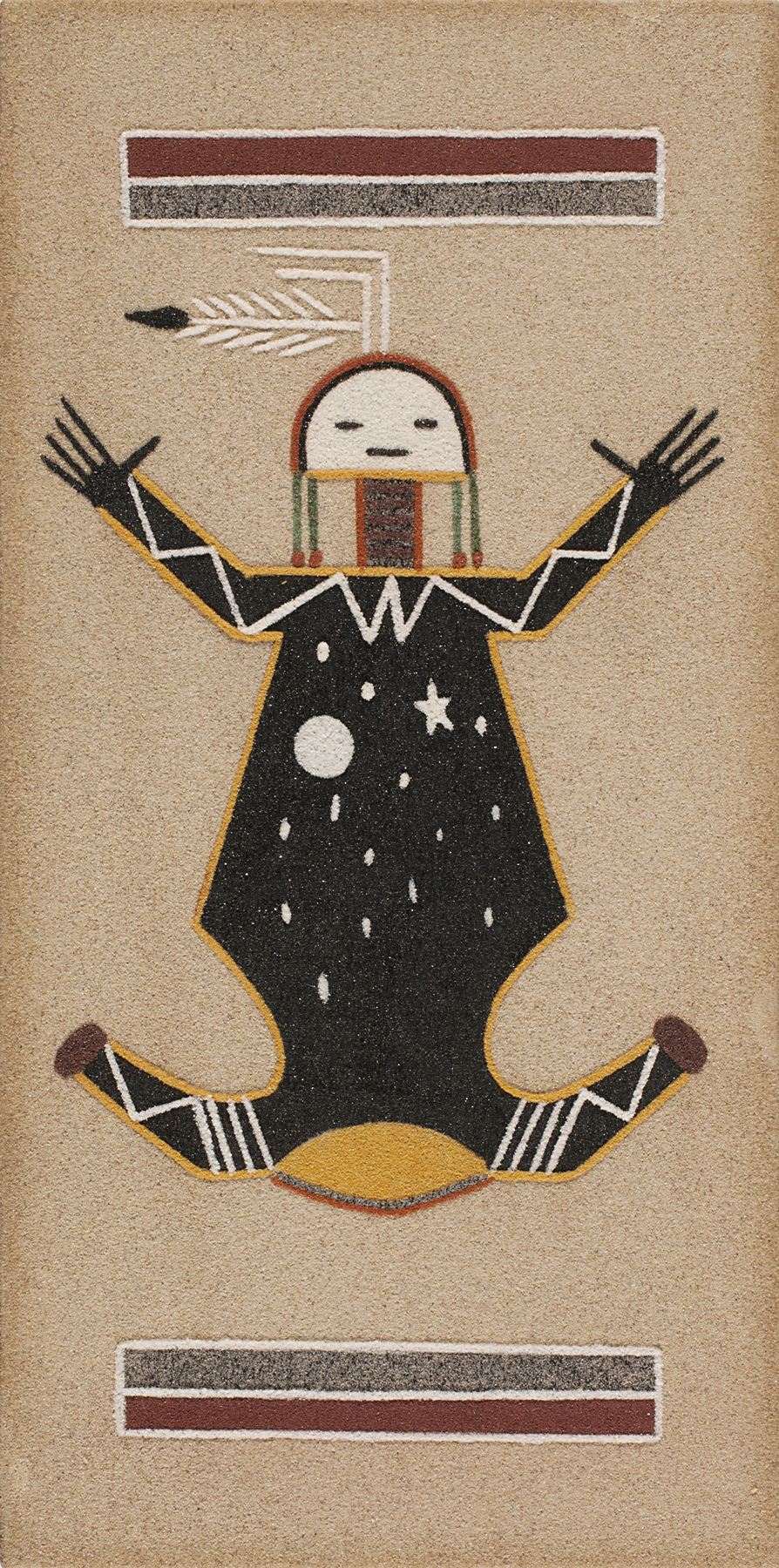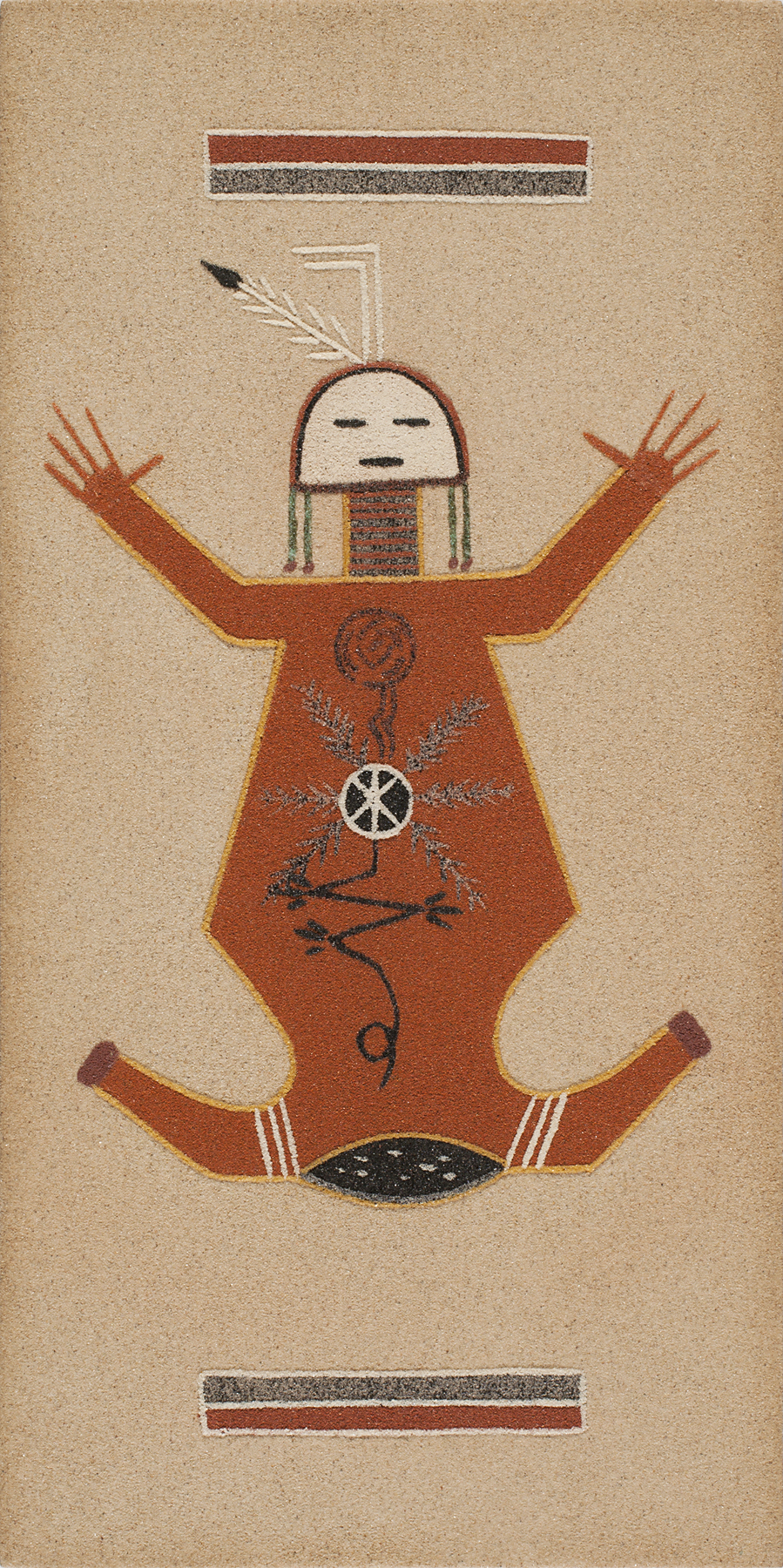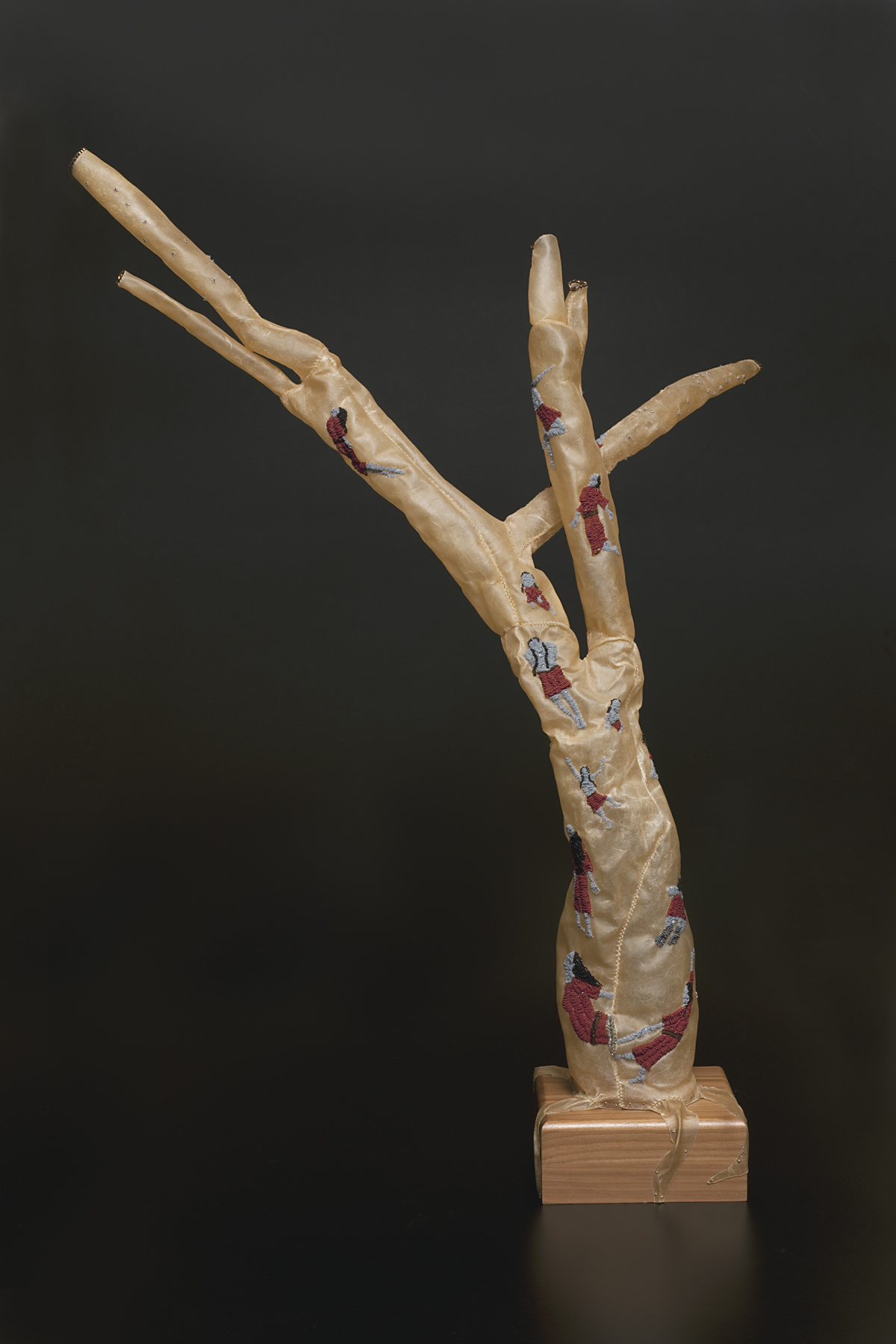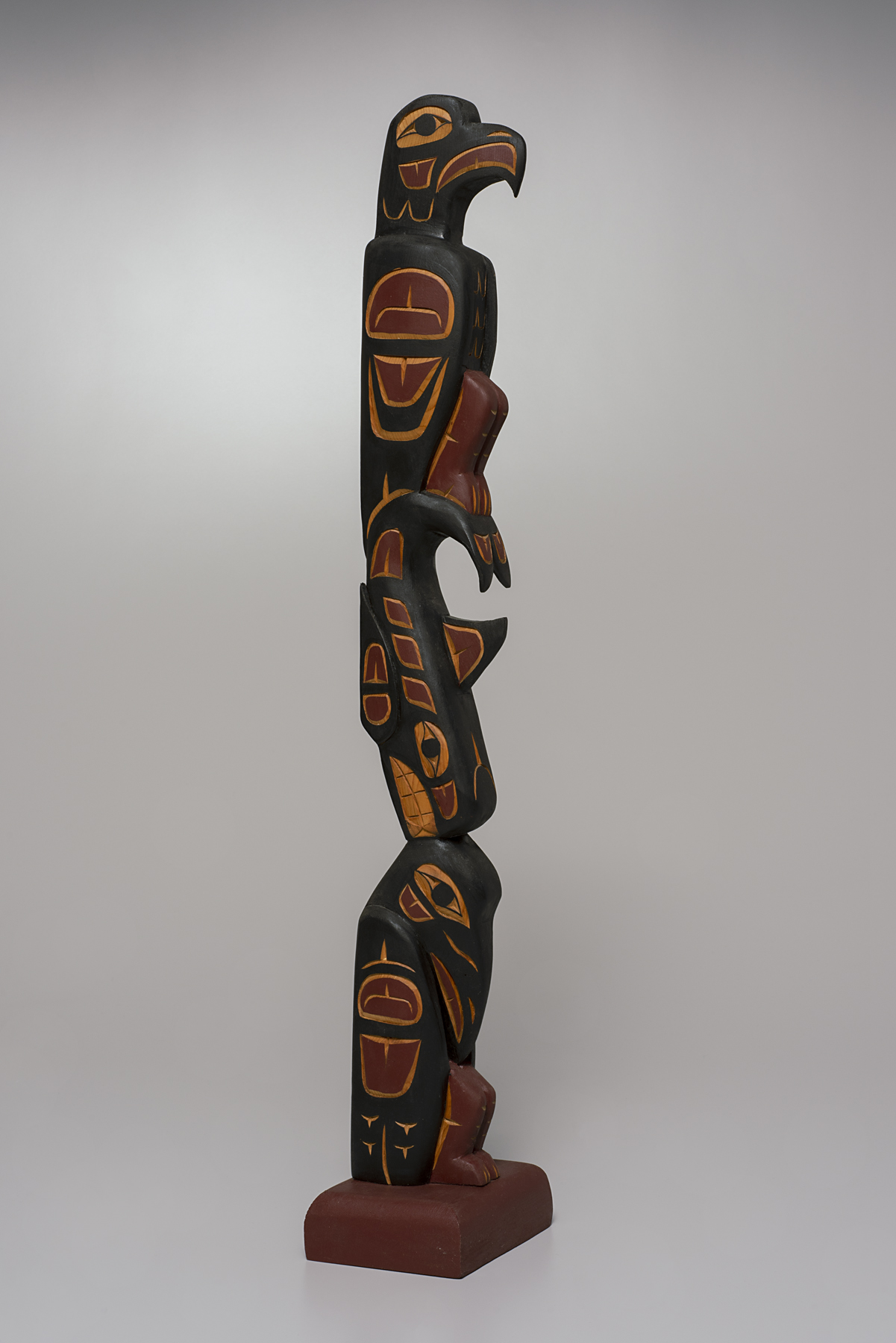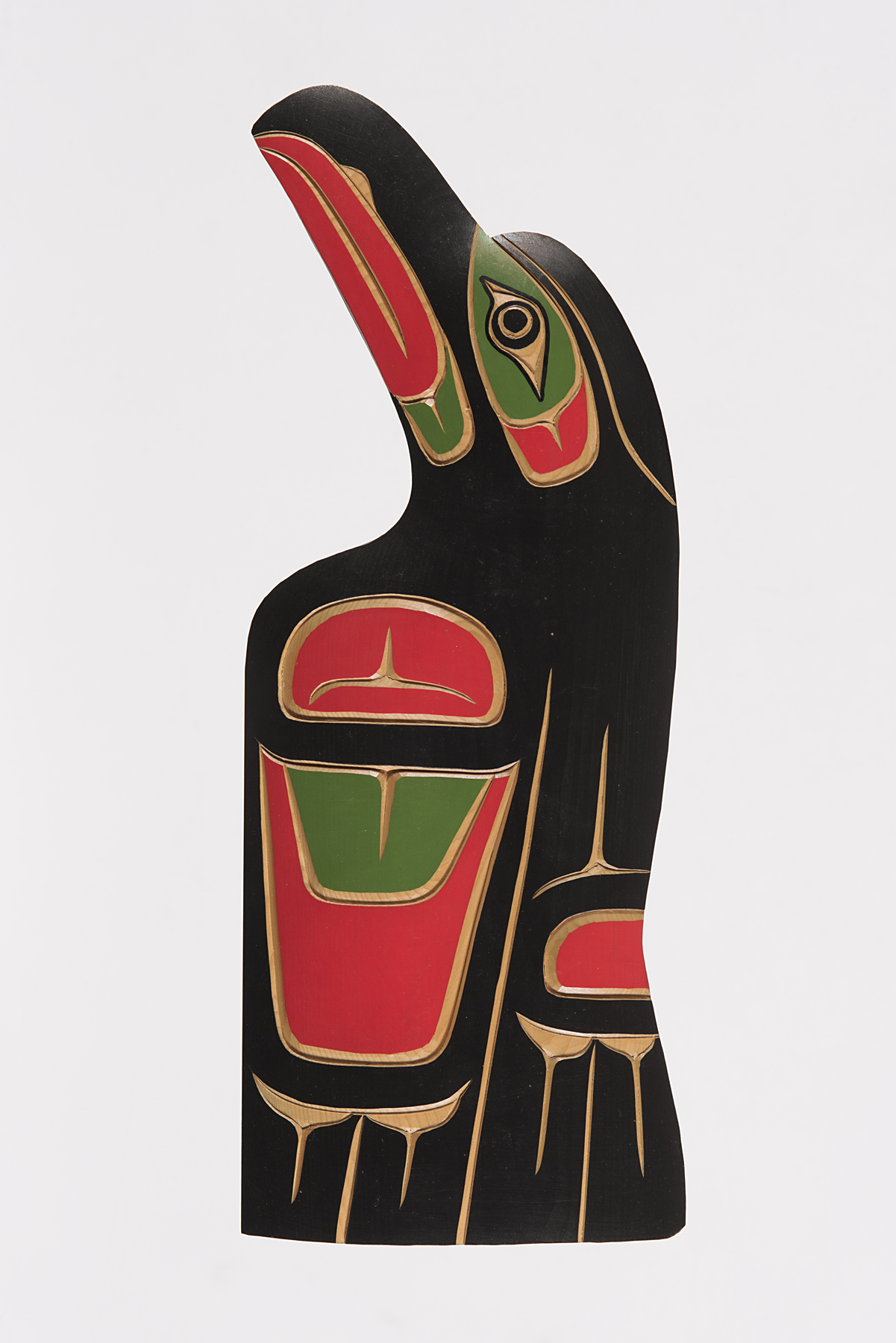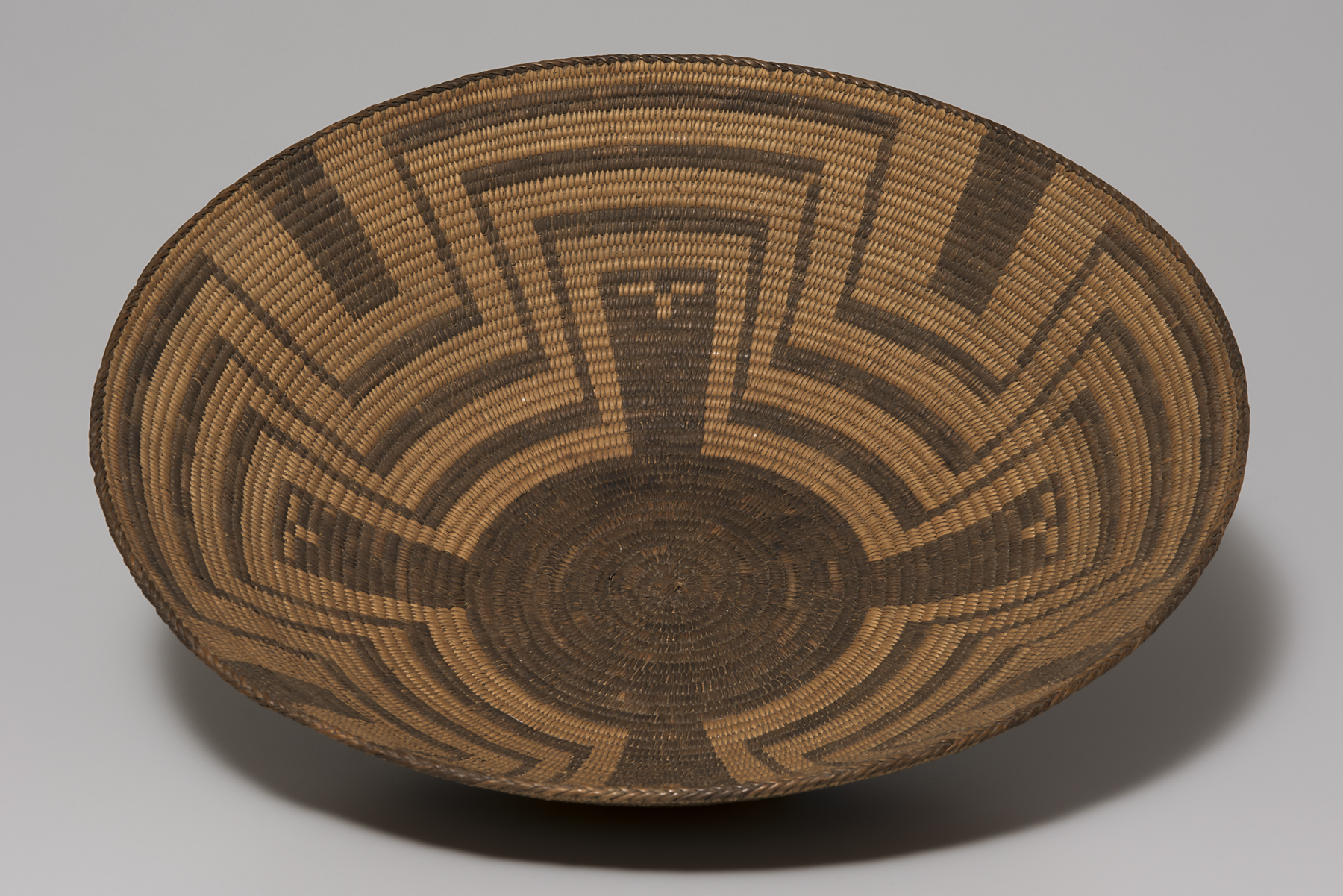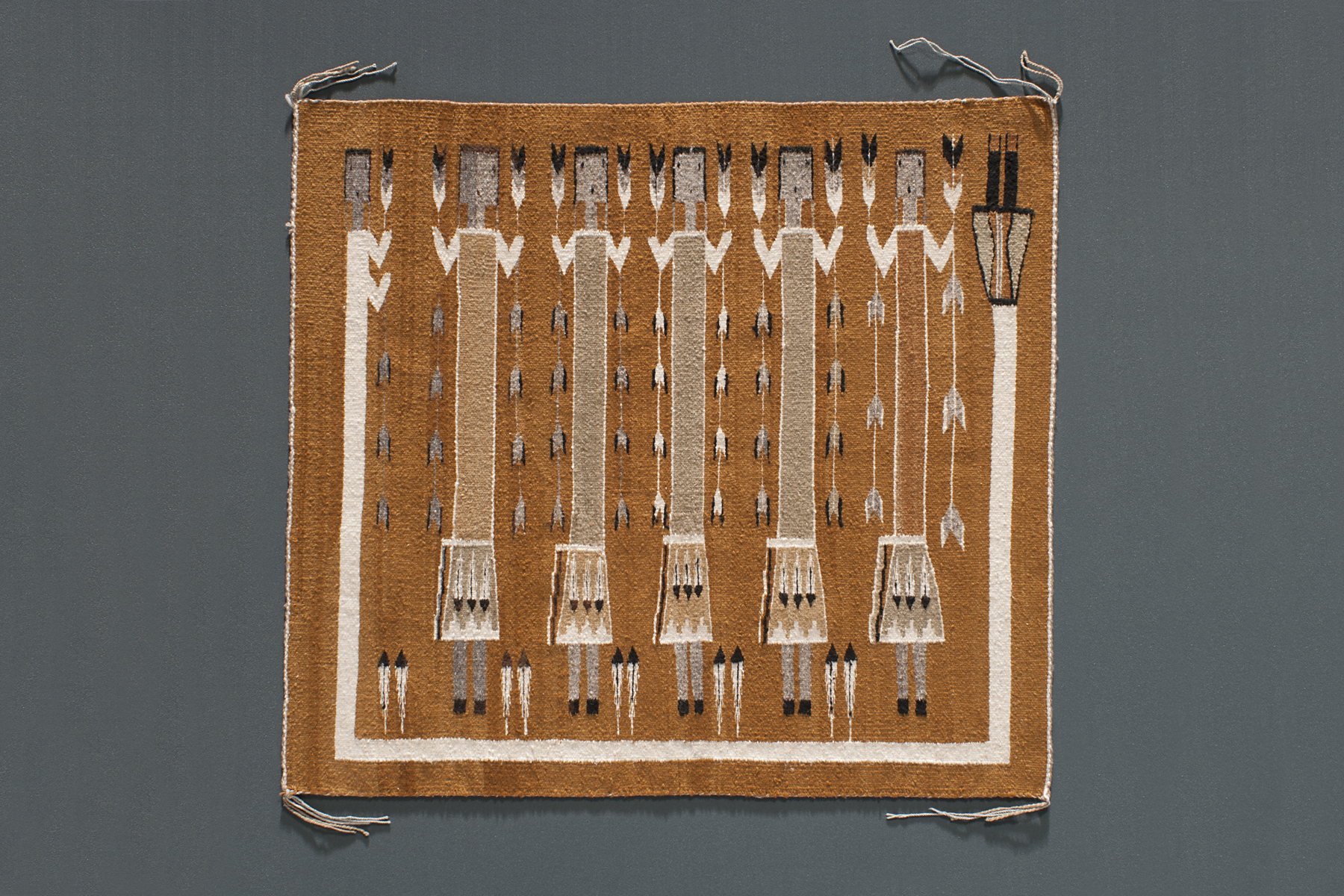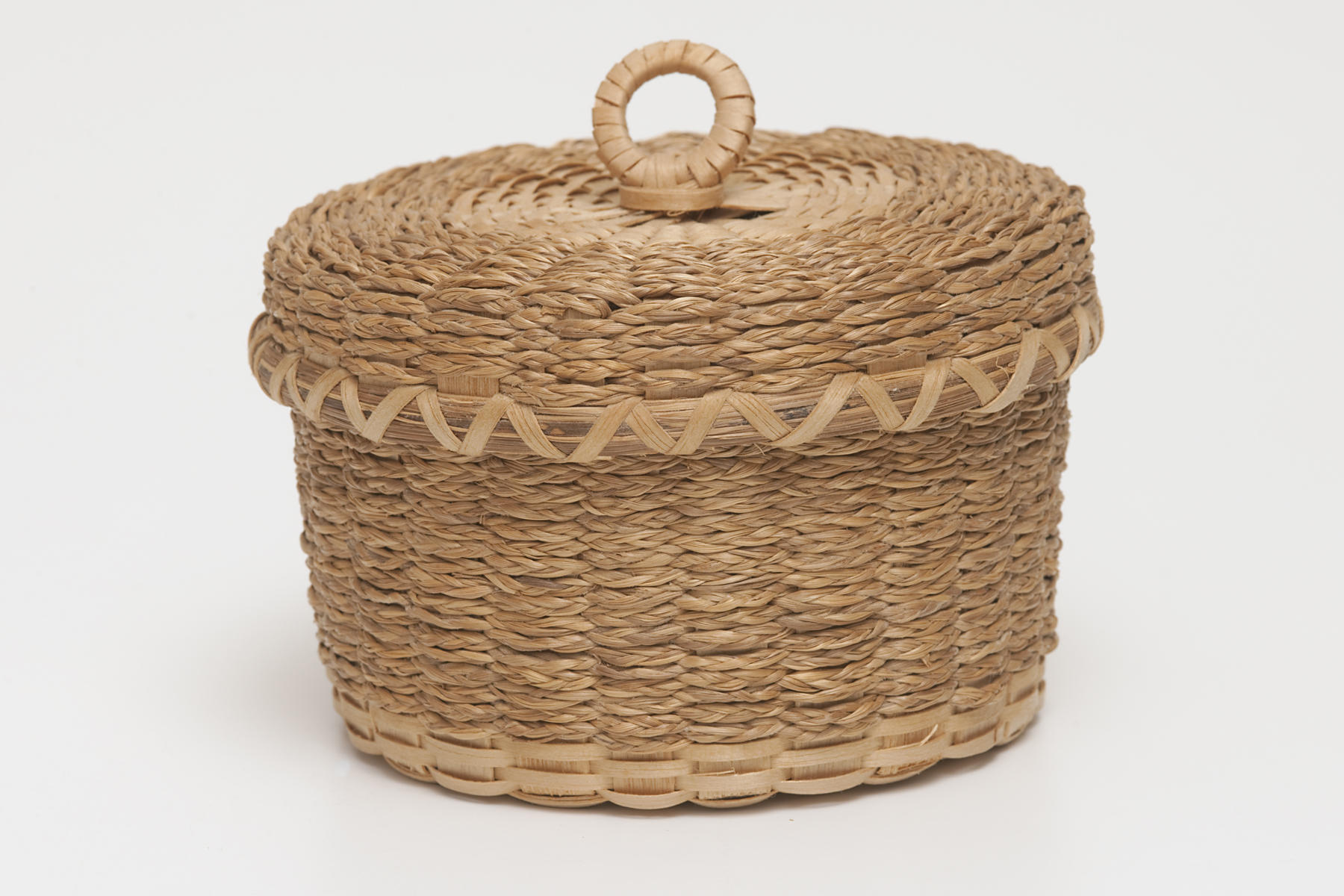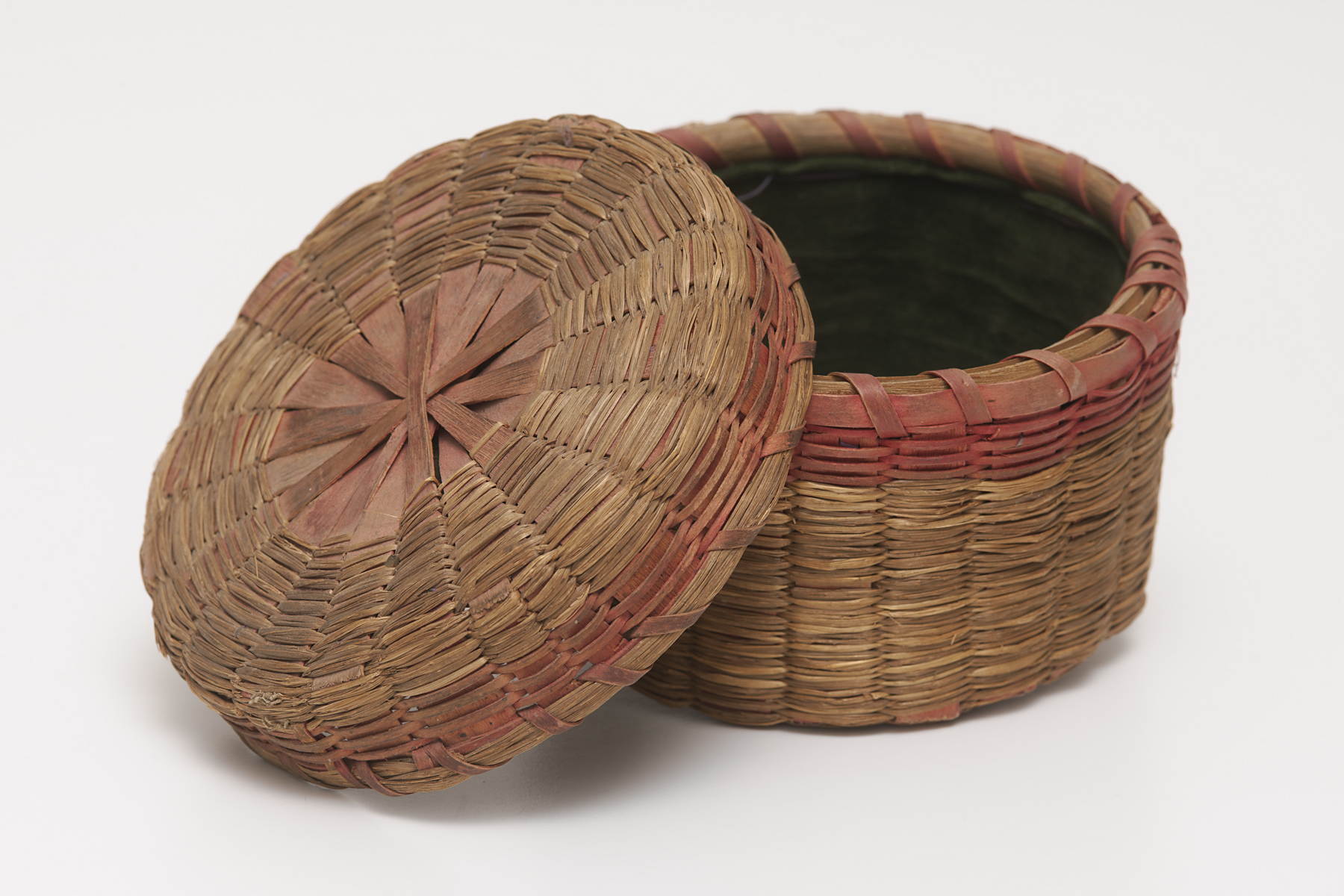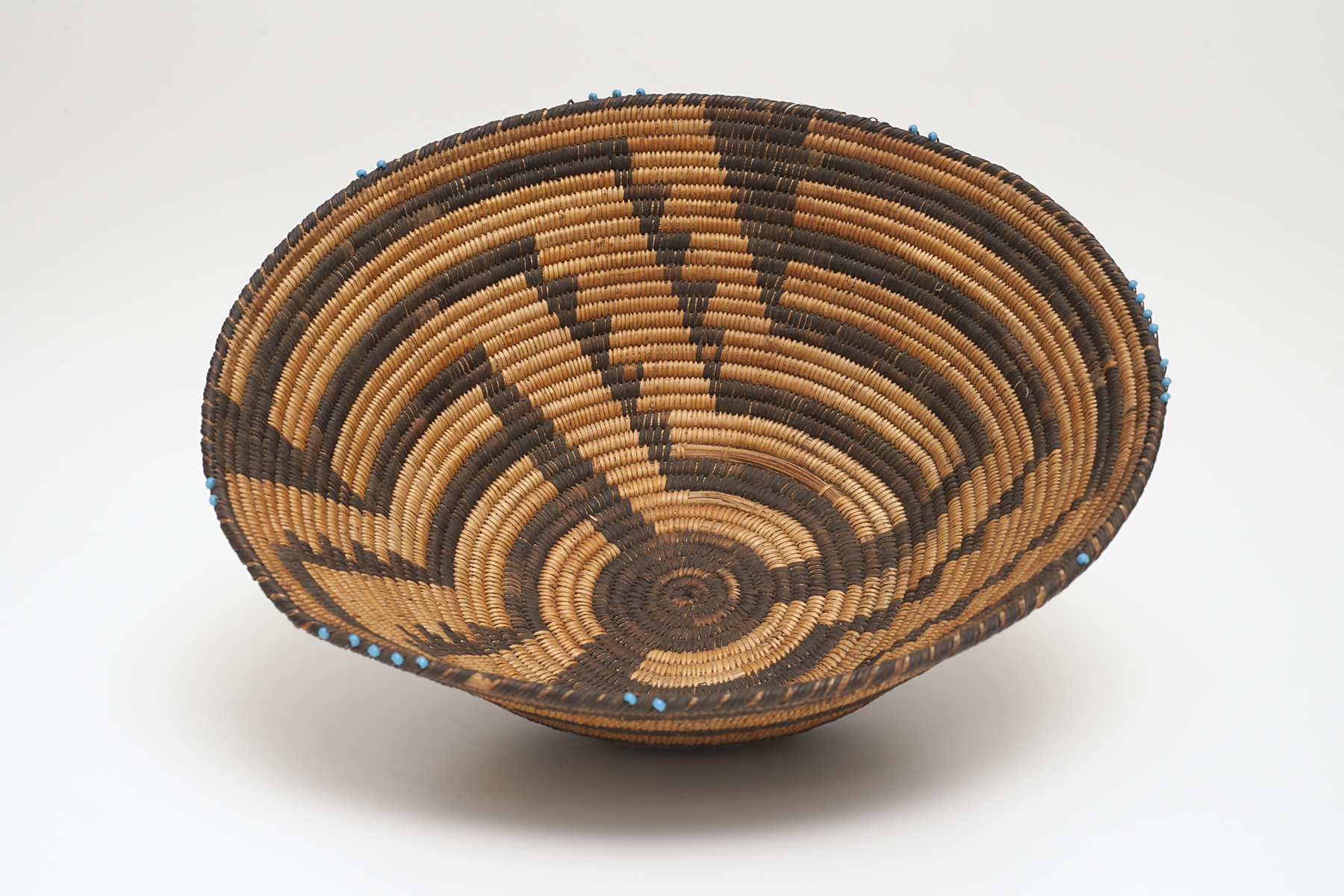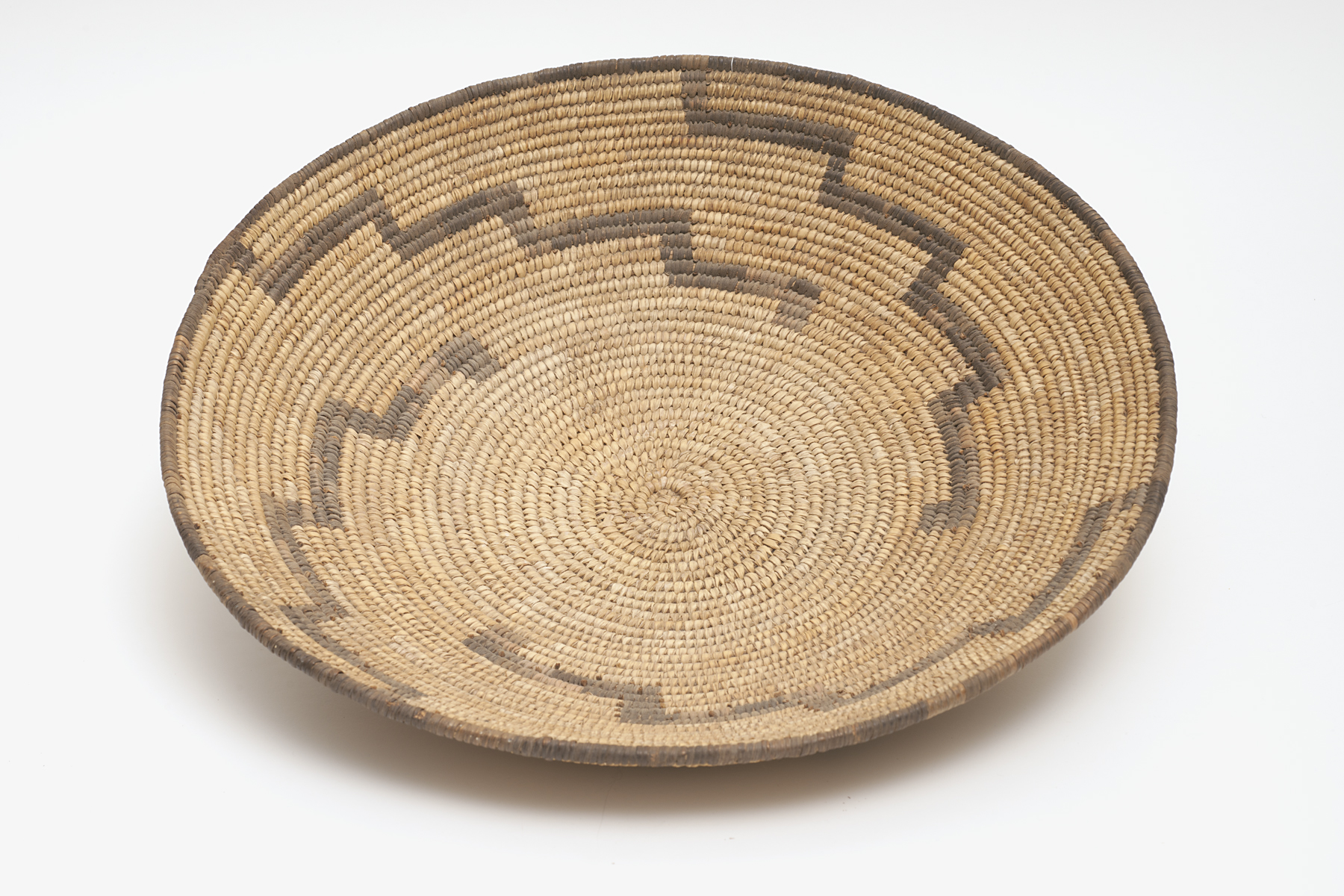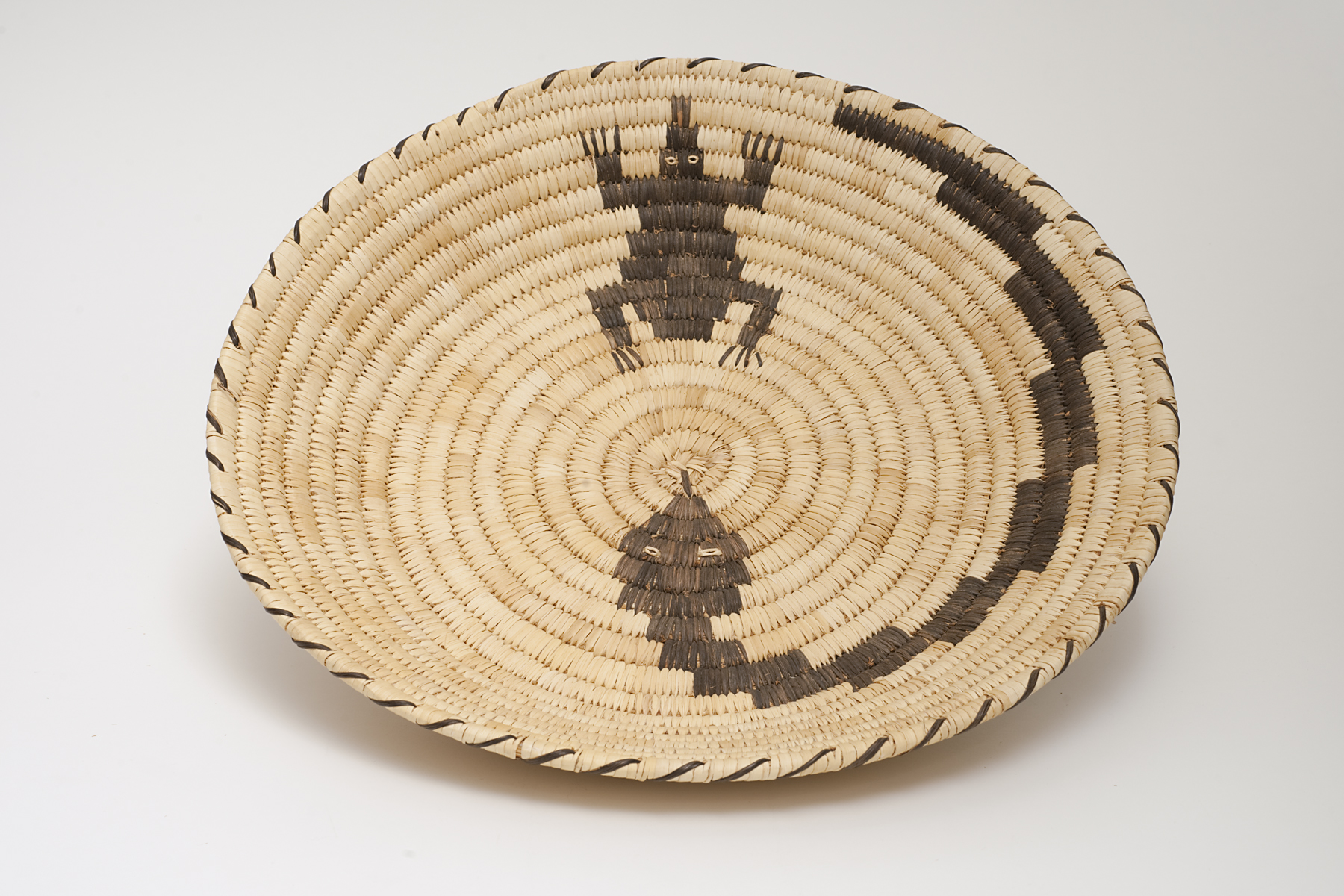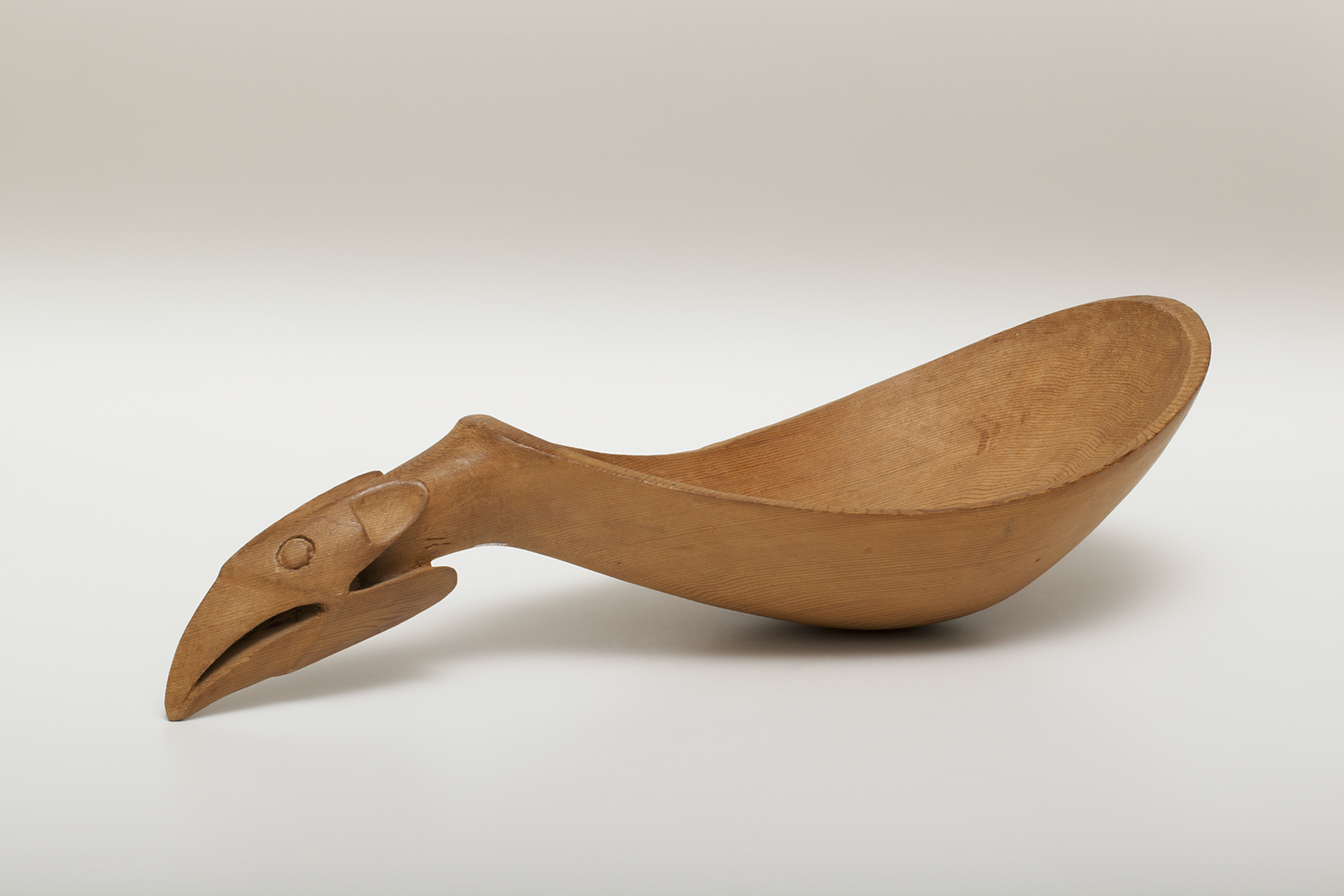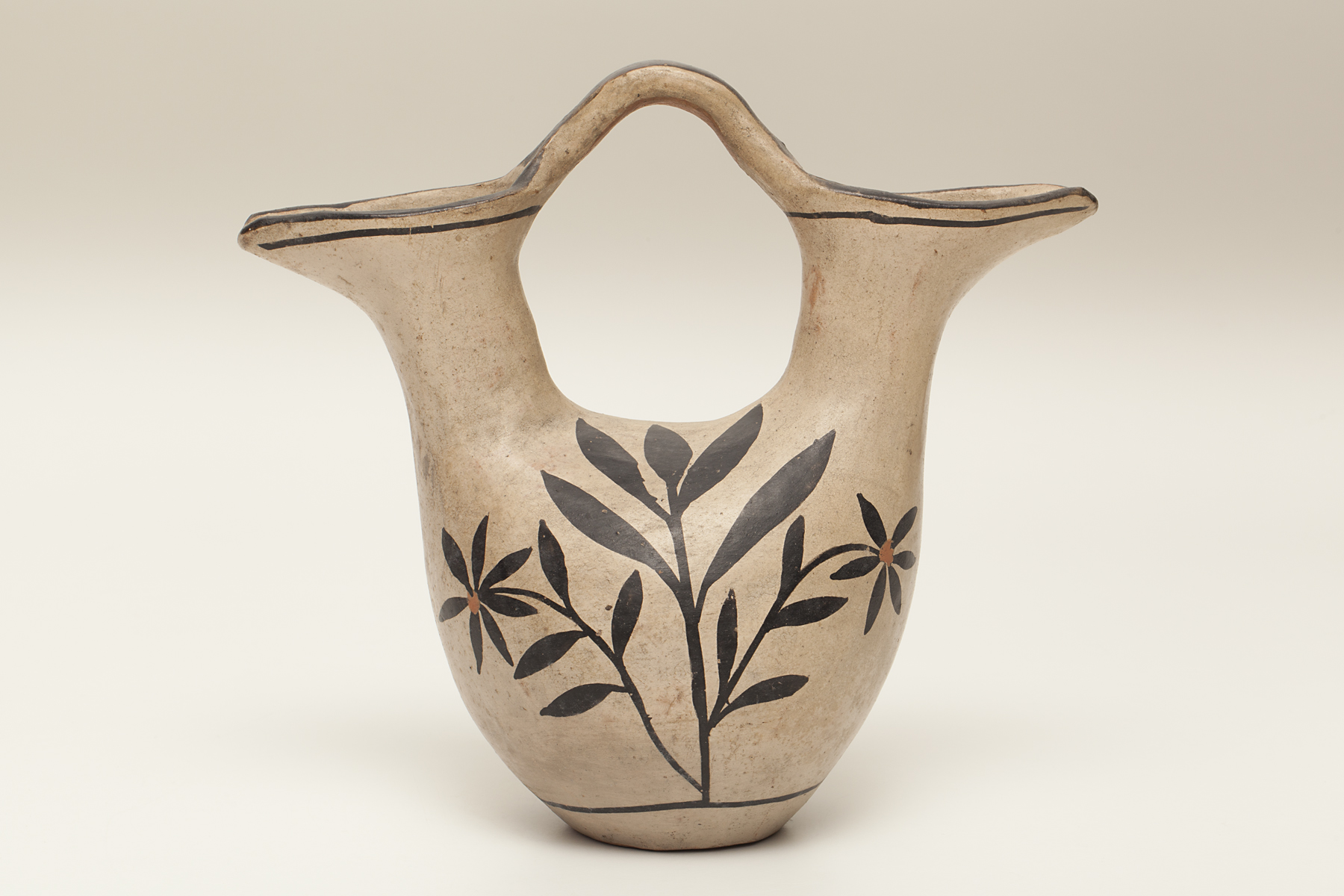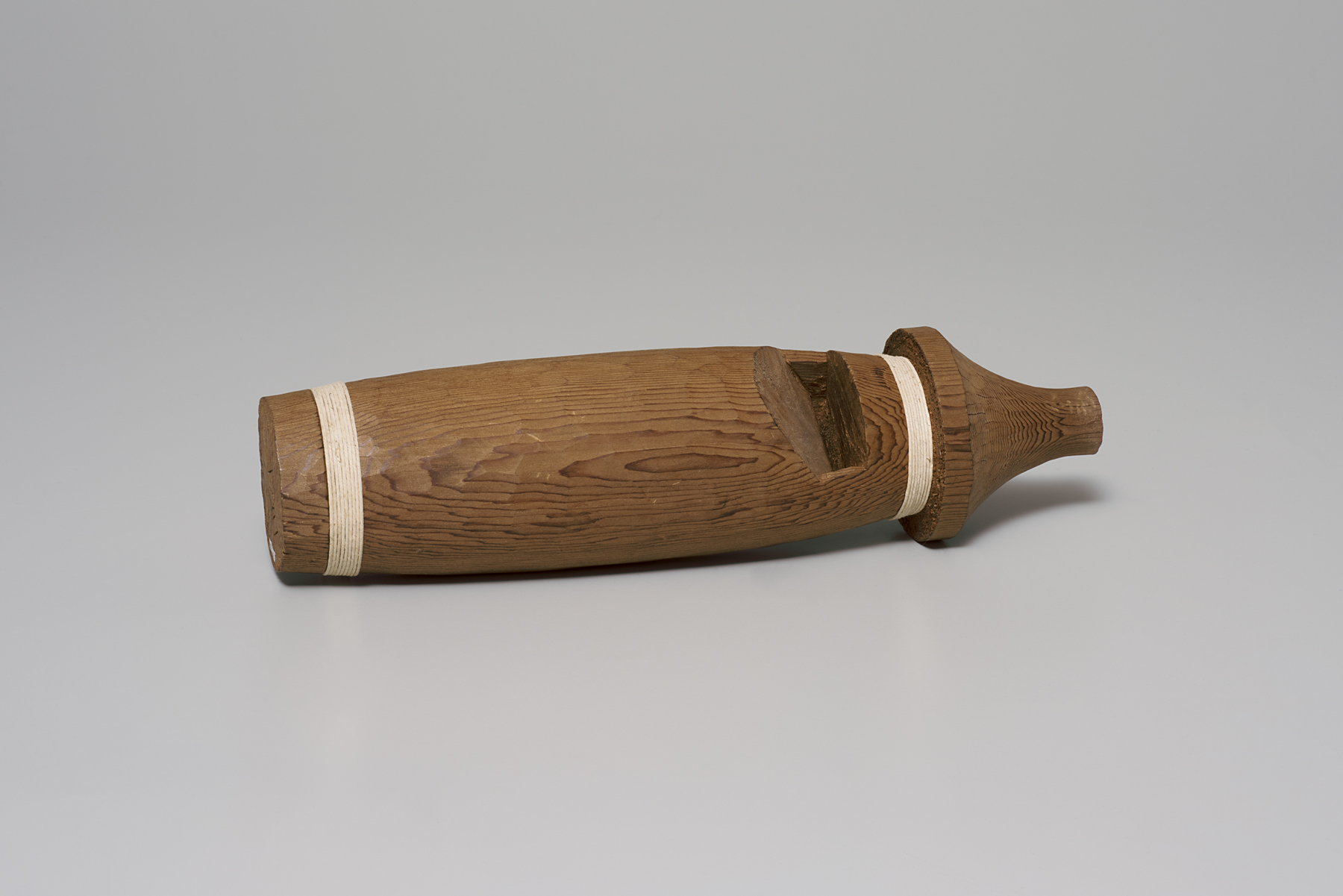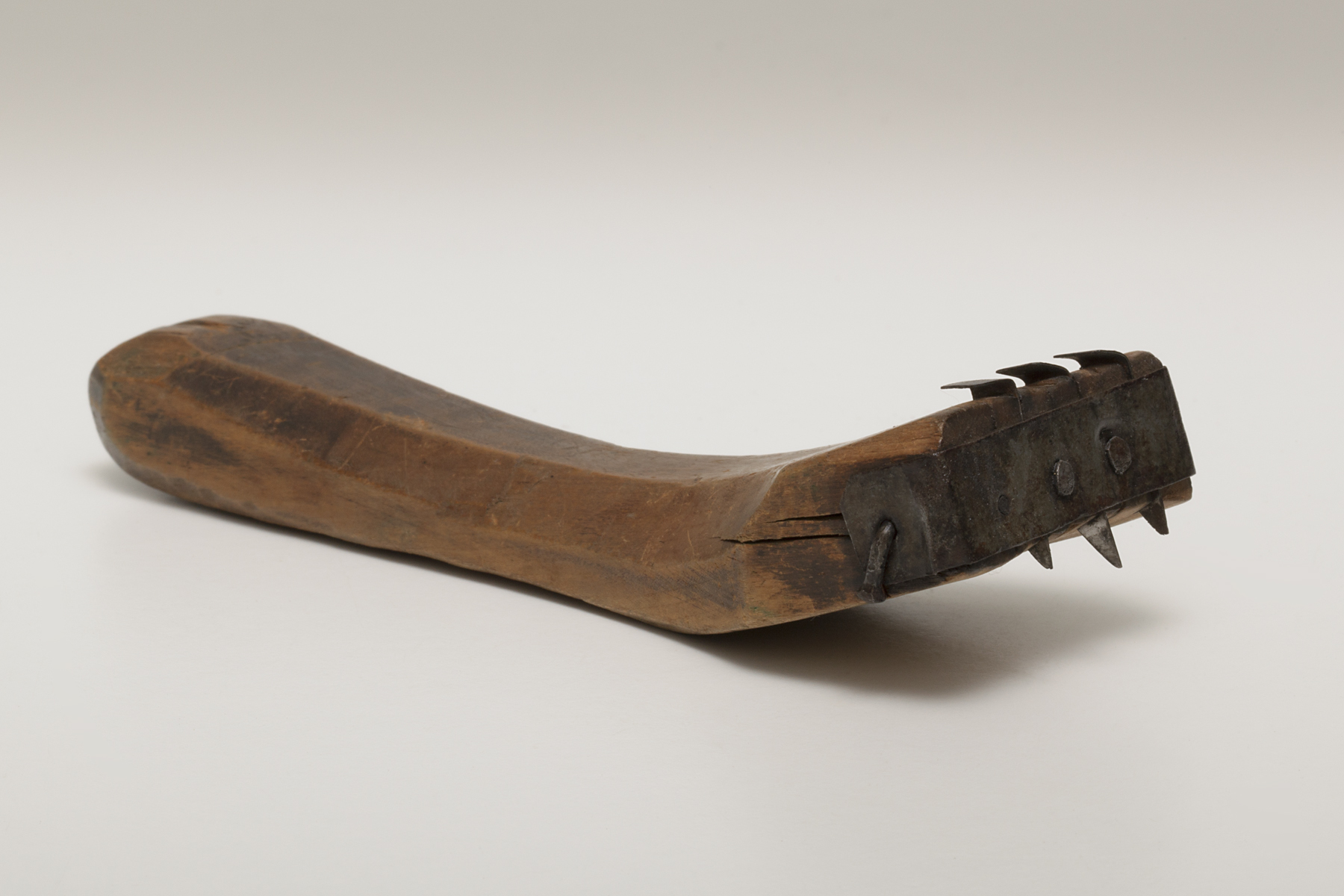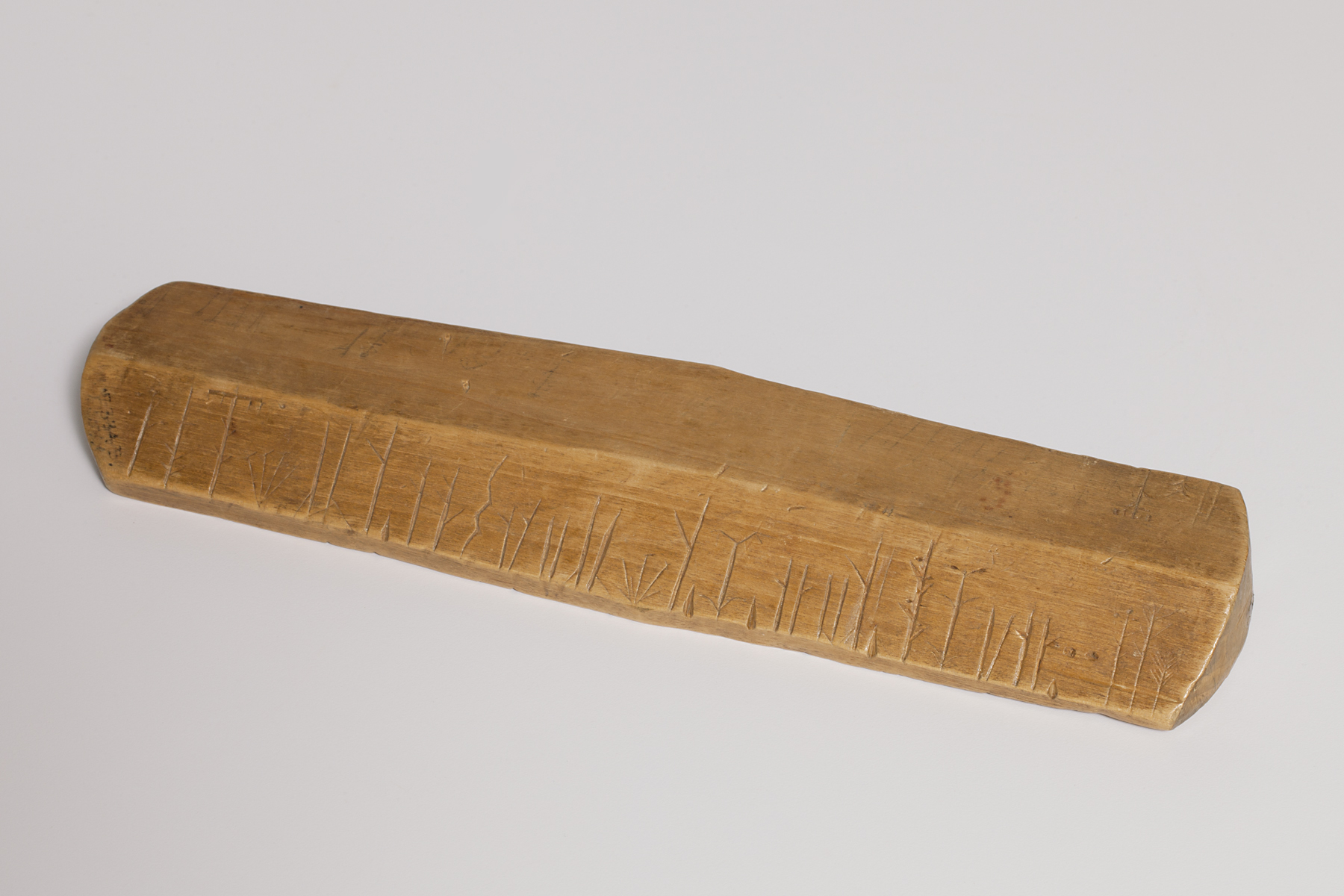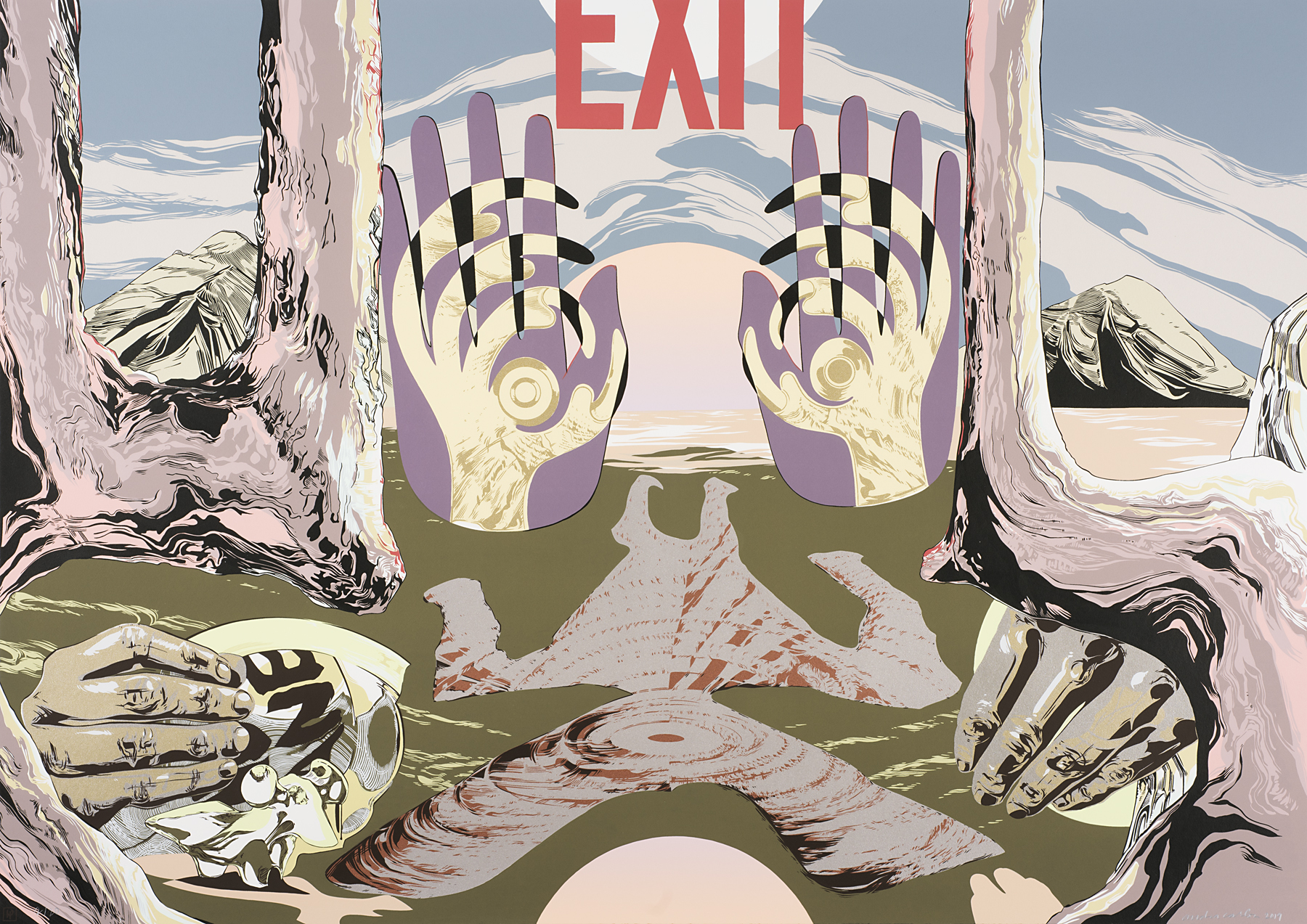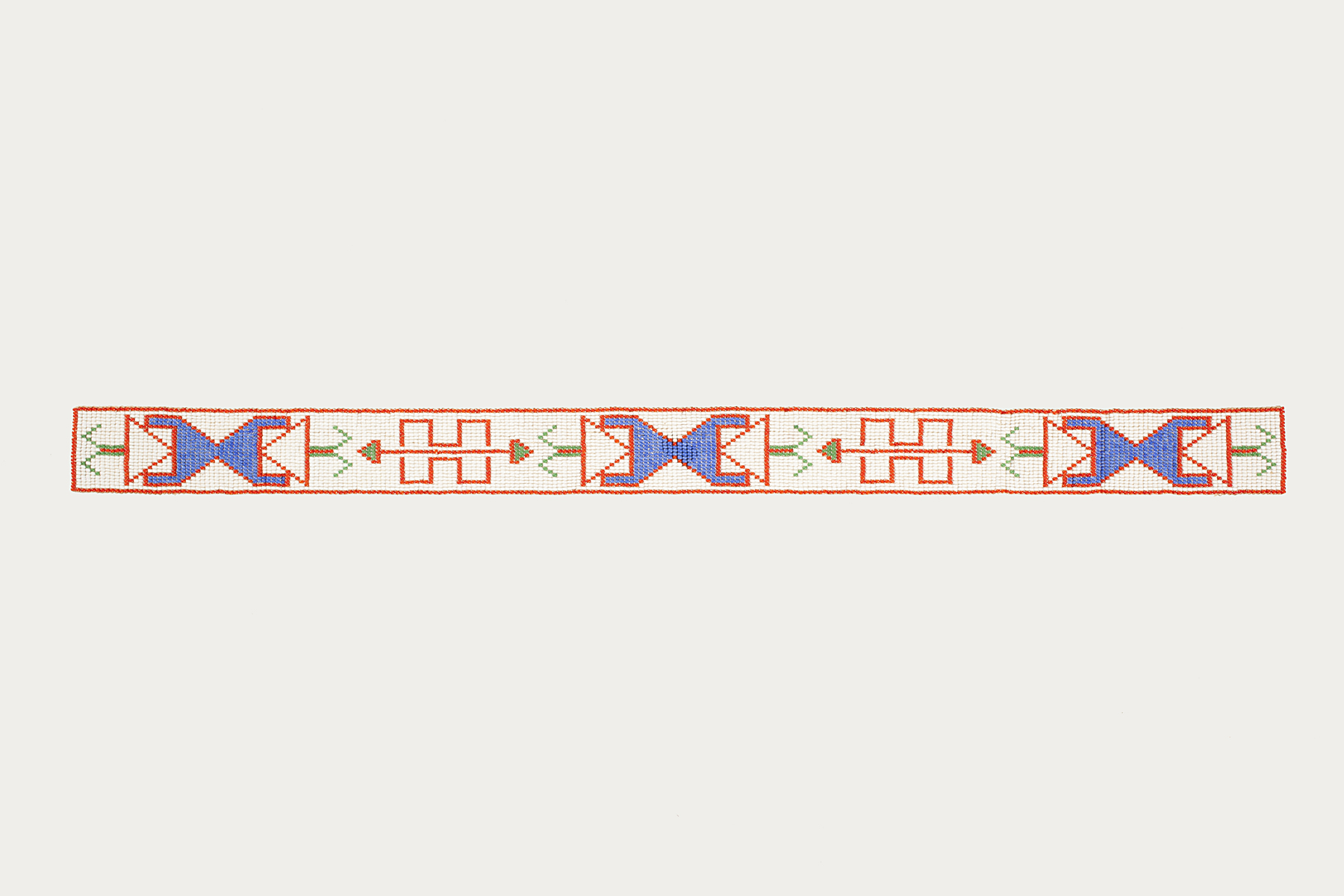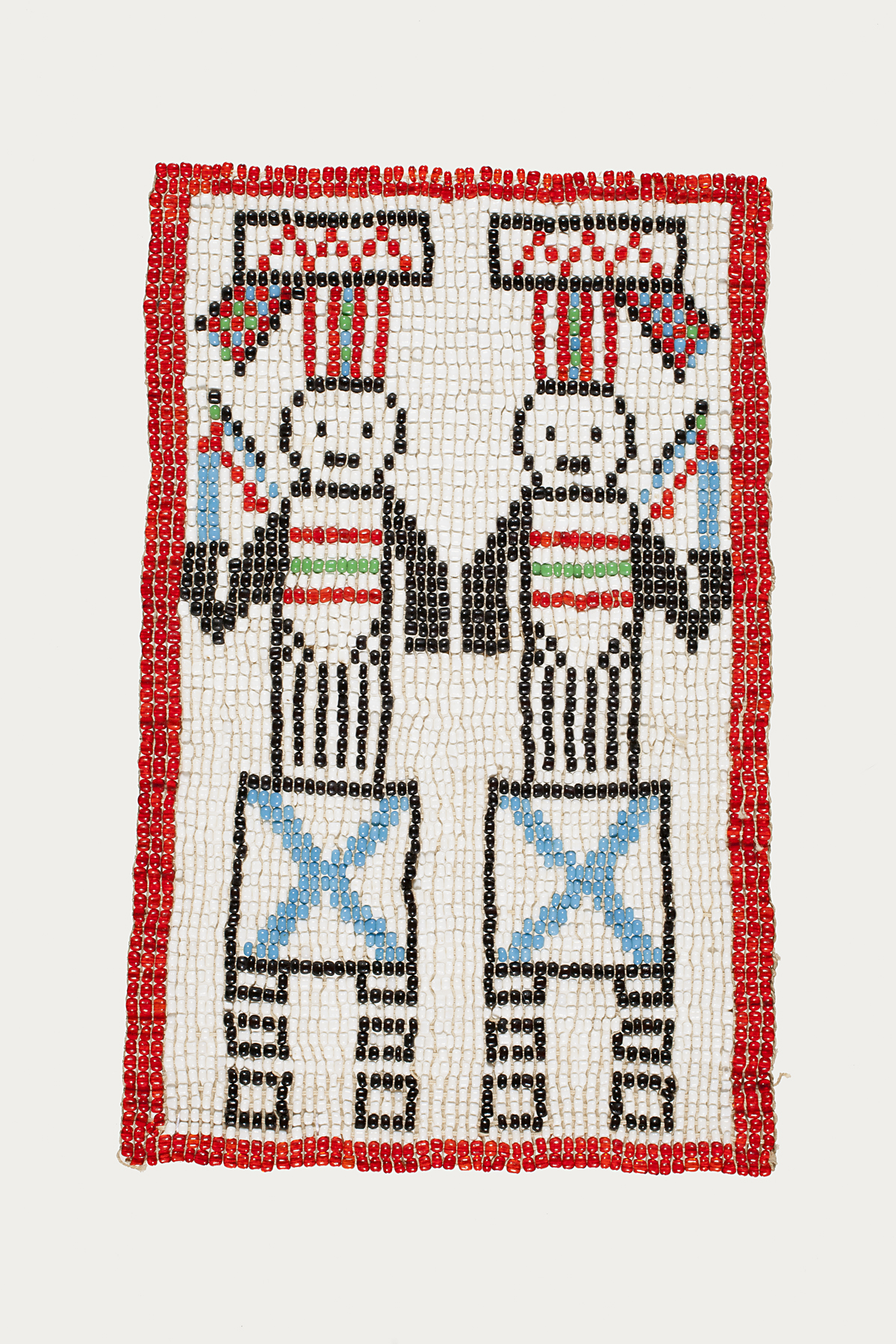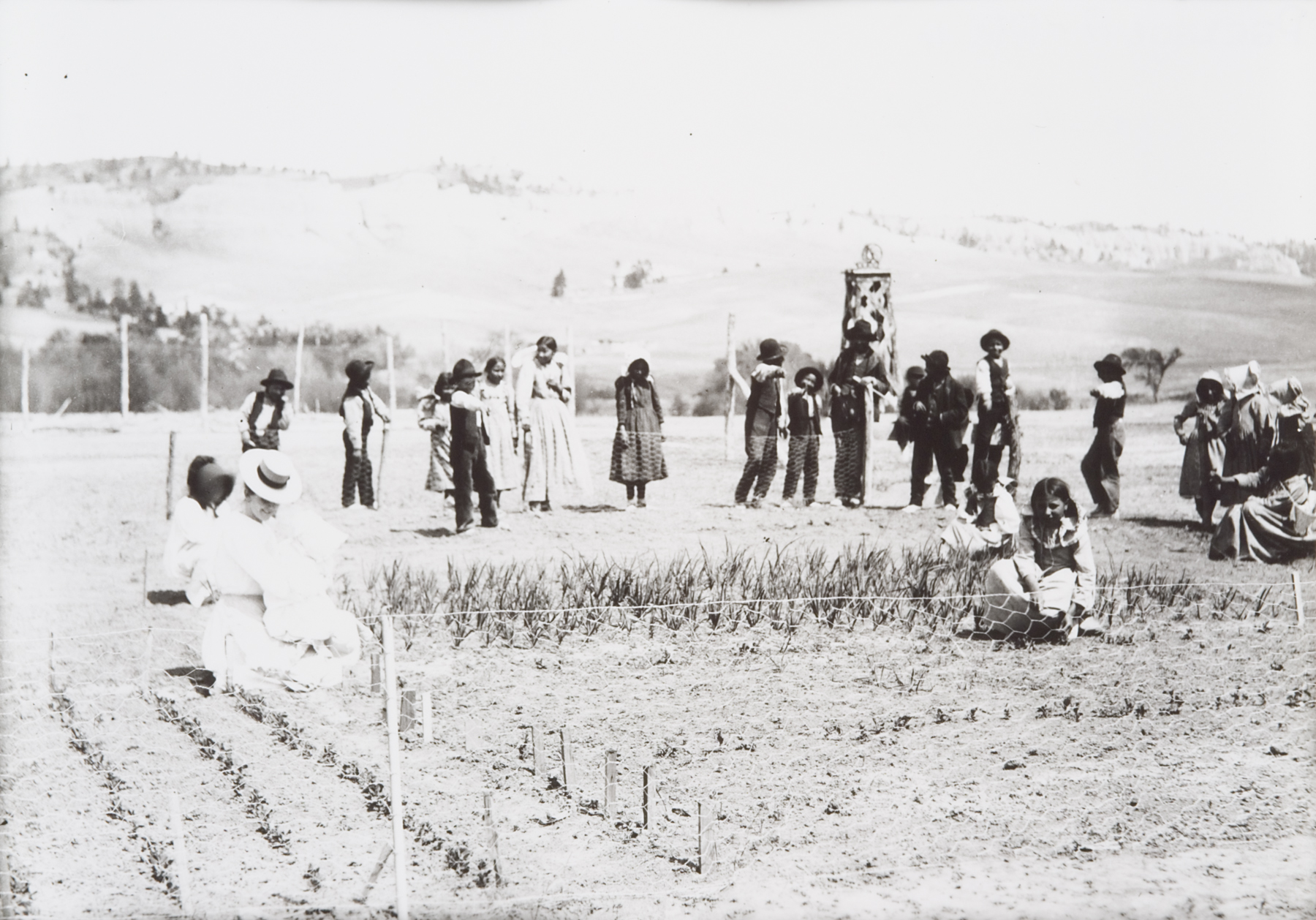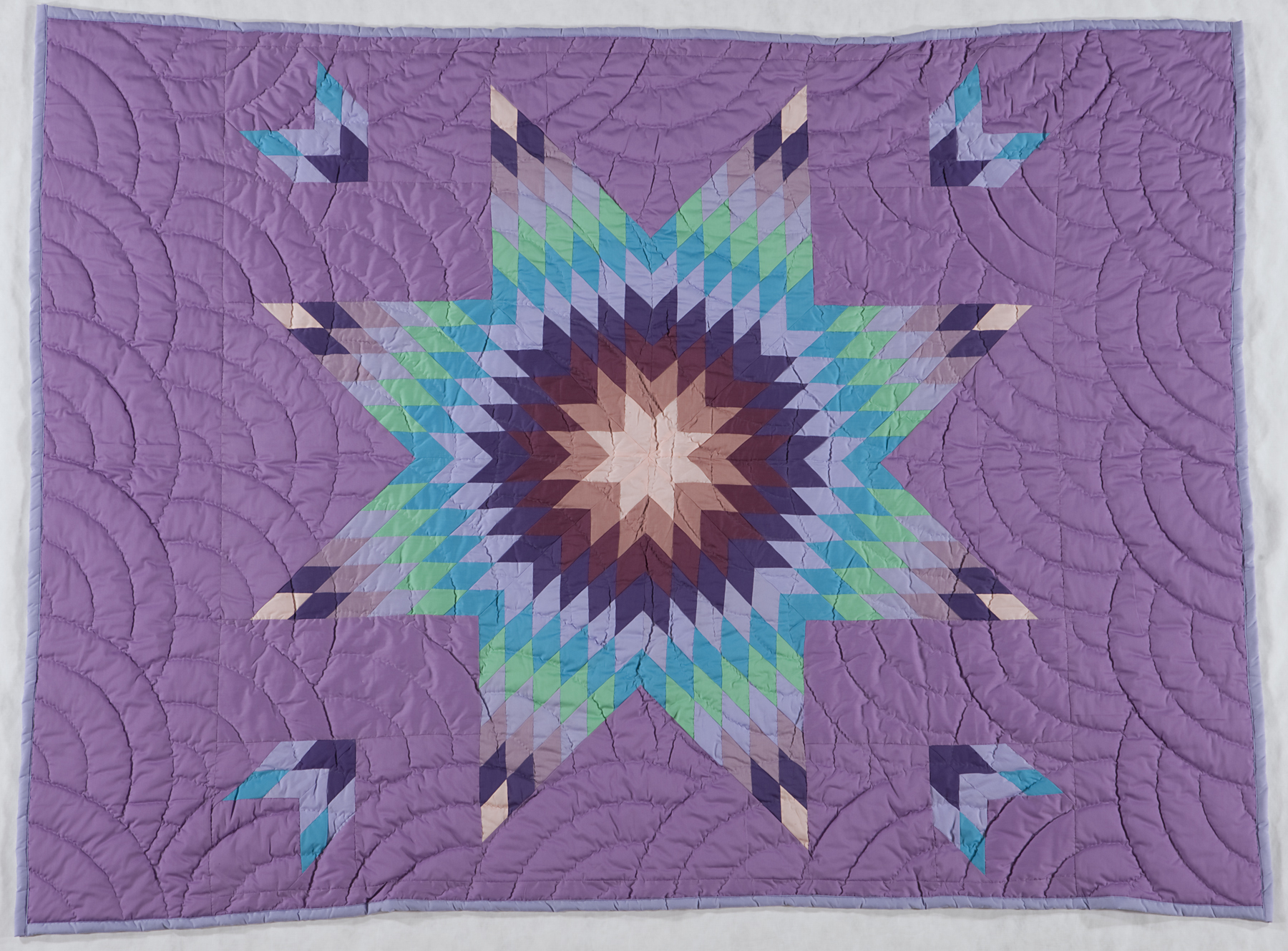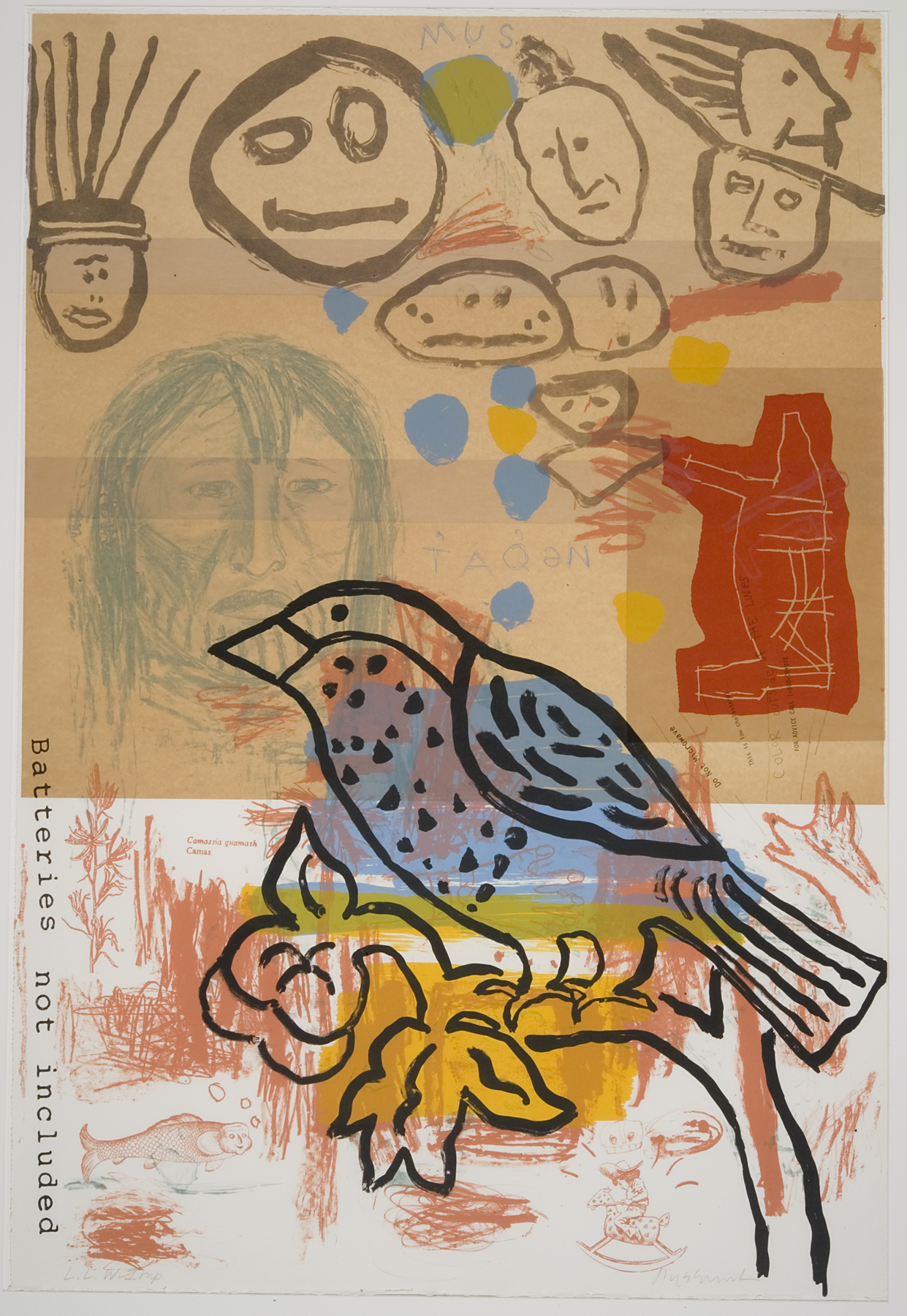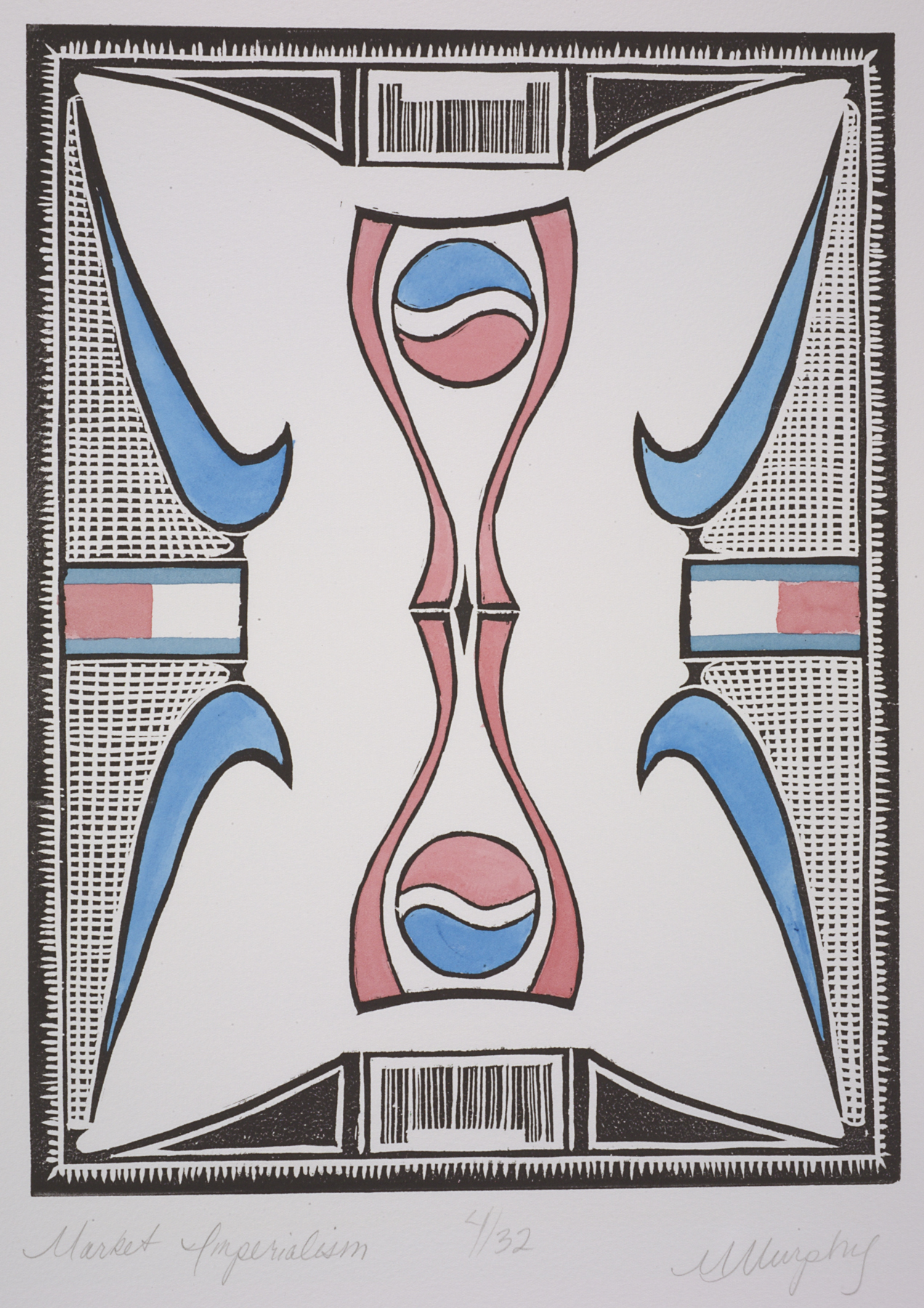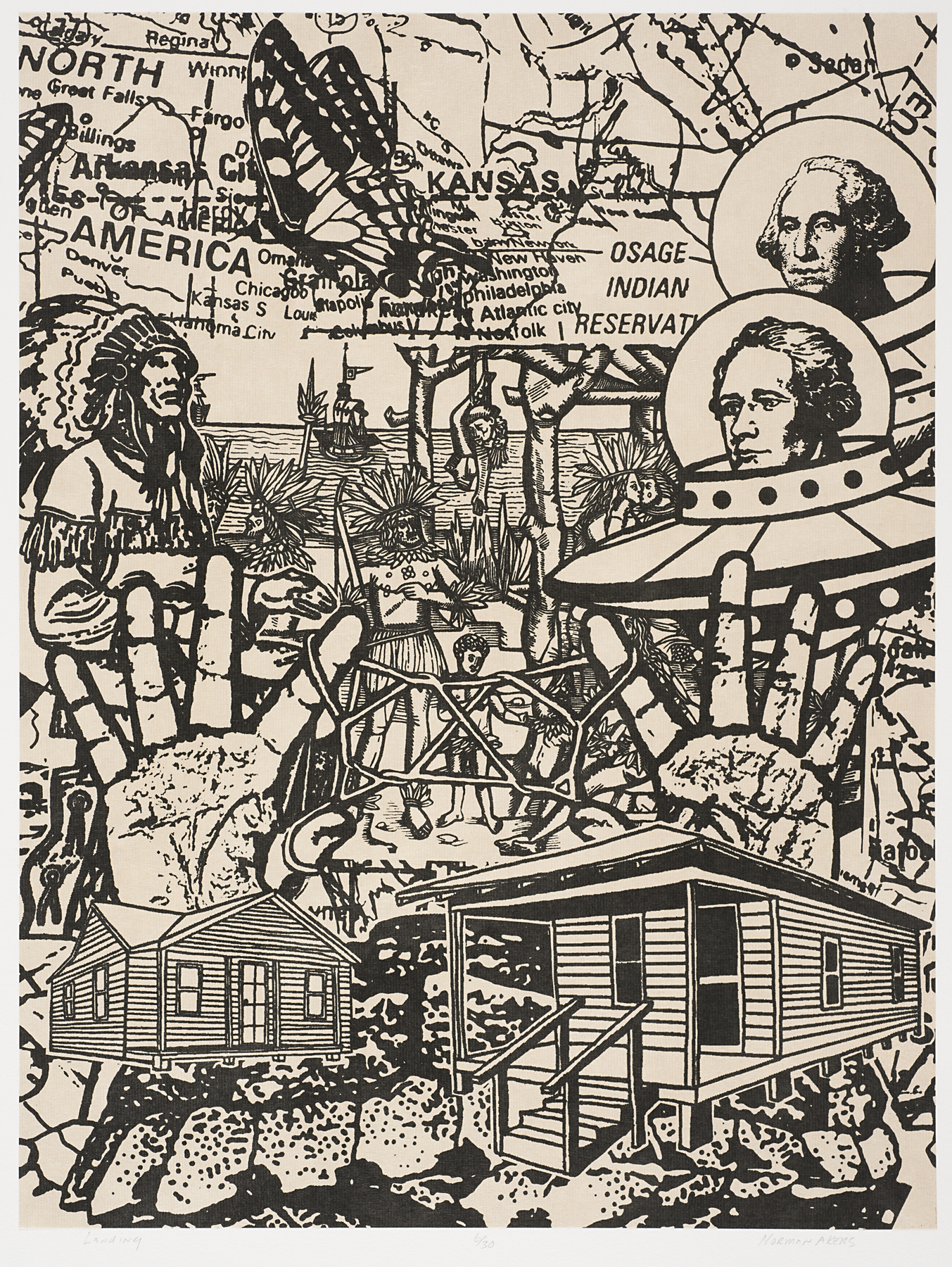The KU Common Book program represents a campus-wide initiative to engage first-year students in a shared reading and learning experience. This year’s selection—Braiding Sweetgrass: Indigenous Wisdom, Scientific Knowledge, and the Teachings of Plants by Robin Wall Kimmerer—has prompted the selection of this year’s Common Work of Art, a series of five signs by Hock E Aye Vi Edgar Heap of Birds. This virtual exhibition expands on Kimmerer’s ambition to cultivate a spirit of reciprocity in which people and land become good medicine for one another. Cultivating Reciprocity is organized into three themes: Indigenous origin and creation stories, the gift of plants, and the history of education for Indigenous peoples. Some of the art included in this virtual exhibition will be on display in the Museum’s Brosseau Learning Center August 17–September 10, 2021. Check our website for current gallery hours and guidelines.
For Kimmerer, who is Potawatomi, her peoples’ creation story includes not just the origins of humans, but the origins of plants. In her chapter titled “In the Footsteps of Nanabozho: Becoming Indigenous to Place,” she recounts the Anishinaabe story of Nanabozho, the first human, in the hopes that his journey to become native to place can guide us, too. When teaching ecology, Kimmerer has found that many students cannot imagine positive interactions between people and land or what a beneficial relationship between the two might look like. The origin and creation stories of Indigenous peoples are often filled with examples of this type of reciprocity.
David V. Lee
Diné (Navajo)
(1948–1996)
Father Sky, late 1900s
Where object was made: New Mexico, United States
sand, pigment
Gift of Forrest E. Jones, 2007.5824
For the Diné, Mother Earth and Father Sky exist in harmony and provide all that is needed to live and thrive on the earth. Father Sky’s body contains the stars, the moon, and the constellations. The body of Mother Earth radiates the life-giving energy of the sun, bringing fertility to her womb where the seeds of all living things begin.
David V. Lee
Diné (Navajo)
(1948–1996)
Mother Earth, late 1900s
Where object was made: Arizona or New Mexico
wood, sand, pigment
Gift of Forrest E. Jones, 2007.5825
For the Diné, Mother Earth and Father Sky exist in harmony and provide all that is needed to live and thrive on the earth. Father Sky’s body contains the stars, the moon, and the constellations. The body of Mother Earth radiates the life-giving energy of the sun, bringing fertility to her womb where the seeds of all living things begin.
Teri Greeves
Kiowa
born 1970
Wind River Reservation, Wyoming
When Saynday Pulled Us Into This World, 2009
Where object was made: United States
rawhide, walnut wood, diamond, sterling silver, beading
Museum purchase: Peter T. Bohan Art Acquisition Fund, 2010.0189
Fashioning rawhide into a tree and embellishing it with beaded figural representations, artist Teri Greeves recounts the origin of the Kiowa in which the hero Saynday pulls the first people out of a tree trunk.
Greeves explains: “The story goes that one day Saynday was walking along. It was the time before the sun had come to this side of the world so he was wandering around in the dark, hands outstretched, searching. Eventually he ran into something that was rough and hard. It was the bark of an old Cottonwood tree. Running his hands around the trunk, he felt an opening and being that crazy old trickster, he stuck a hand down into it feeling deeper and deeper into the darkness. Suddenly another hand grasped his hand. A sane person would have run away but Saynday, being Saynday, grasped the hand back and started to pull. The first man emerged from the underworld through the hole in that old Cottonwood tree. He was the first Gkoy-goo K’he to come into the world. Saynday didn’t stop though. He kept reaching into the hole and pulled out several more people, men and women, from the underworld. Soon he had the hand of a woman. She was pregnant and due to her size, she got stuck in the hole. No more people could emerge from the underworld and it is said that is why the Gkoy-goo, the Kiowa, are small in number to this day.”
Brad Starr
Haisla
born 1957, active 1995–present
Kitimat, British Columbia, Canada active Canada
Eagle, Killer Whale, and Raven totem, circa 2002
Where object was made: British Columbia, Canada
yellow cedar wood, paint, carving
Gift of Ellie LeCompte, 2016.0229
This miniature totem was carved by Haisla artist Brad Starr. Like many Indigenous communities of the Pacific Northwest Coast, citizens of the Haisla Nation are organized into clans. Today, there are four Haisla clans—Killer Whale, Eagle, Raven, and Beaver—each of which has a unique origin story that connects with broader myths about Haisla creation. Starr, who is a member of the Killer Whale clan, depicts his own clan crest as well as those of the Eagle and the Raven. These clans are inherited through female relatives in Haisla society.
Roselyn Rouchman
Diné (Navajo)
rug depicting Mother Earth and Father Sky, mid-late 1900s
Where object was made: Southwestern United States
wool yarn, weaving, dyeing
Gift from the Security Benefit Group of Companies, 2007.6621
This woven rug depicts Mother Earth and Father Sky, a duo that exemplify perfection, harmony, and balance among the Diné. Here, Father Sky is shown above with stars and celestial bodies in his torso, while Mother Earth is shown below with a small figure in her abdomen, referencing fertility and the human and agricultural lifecycles. Surrounding the figures is a long-bodied yei—a supernatural being that facilitates communication between the Diné and their deities. This particular yei is often referred to as the Rainbow Yei.
Matthew Baker
Kwakwaka'wakw (Kwakiutl), Squamish
born 1953
Capilano Reservation, Vancouver, British Columbia, Canada
Raven, circa 2000–2005
Where object was made: Vancouver, British Columbia, Canada
yellow cedar wood, paint, carving
Gift of Ellie LeCompte, 2016.0228
In this plaque, Squamish and Kwakwaka’wakw artist Matthew Baker depicts Raven using a traditional palette of red, black, and blue-green pigments on unstained yellow cedar. Raven is an integral character in many human and animal creation stories among the Indigenous peoples of the Pacific Northwest Coast, where he often acts as a trickster. Among the Squamish, Raven symbolizes knowledge, creativity, and humor, whose misbehaviors often bring important changes to communities.
Minnie S. Foster
(Hopi)
The Water Way Chant, mid 1900s–1993
Where object was made: Southwestern United States
wood, sand, pigment
Gift from the Menninger Foundation, 2007.5823
This sand painting depicts four frogs interspersed among pumpkin, beans, corn, and tobacco plants. Their positions reference the Four Directions, which particular tribes associate with different colors, plants, animals, life stages, seasons, and elements. The number four is also sacred for many Indigenous communities.
Kimmerer discusses the significance of the number four: “Native scholar Greg Cajete has written that in indigenous ways of knowing, we understand a thing only when we understand it with all four aspects of our being: mind, body, emotion, and spirit. I came to understand quite sharply when I began my training as a scientist that science privileges only one, possibly two, of those ways of knowing: mind and body. As a young person wanting to know everything about plants, I did not question this. But it is a whole human being who finds the beautiful path.” [p. 47]
unknown Akimel O'odham (Pima) maker
active Arizona
large bowl with geometric patterns, early 1900s
willow, martynia, coiling
Anonymous gift in loving memory of Jane and Tom Apostol, 2020.0024
In Braiding Sweetgrass, Kimmerer recounts learning how to make a basket with renowned Potawatomi basket maker John Pigeon. After harvesting the materials, he instructs Kimmerer on how to make the bottom of the round basket, explaining “’You’ve started with the four directions in front of you. It’s the heart of the basket. Everything else is built around that.’ Our people honor the four sacred directions and the powers resident there.” [p. 151]
This Akimel O’odham basket from Arizona features a “Four Directions” motif surrounded by geometric designs that recall the “Man in the Maze” pattern Akimel O’odham basket makers have used since the early 1900s. According to oral history, this design reflects the many decisions we make and paths we take throughout our lives. When one reaches the center, it offers an opportunity to look back on our choices before passing over into the next world.
unknown Diné (Navajo) maker
active Arizona, Utah, and New Mexico
yei rug, early-mid 1900s
Where object was made: possibly Lukachukai, Arizona, United States
wool yarn, weaving, dyeing
Gift from the Menninger Foundation, 2007.6545
This Diné rug depicts five yei—benevolent supernatural beings that fill healers with their power. Yei were historically depicted in sand paintings created by a medicine man to restore balance and harmony alongside physical, emotional, and spiritual health. These sand paintings would be erased after the healing ceremony ended. At the turn of the 20th century, weavers began translating the ephemeral imagery of sand paintings into fixed scenes on woven rugs, like this one. The elongated figure surrounding the yei on three sides has been identified as the Rainbow Yei.
unknown Diné (Navajo) maker
active Arizona, Utah, and New Mexico
yei rug, early-mid 1900s
Where object was made: Southwestern United States
wool yarn, weaving, dyeing
Gift of Ann and Britt Brown, Blackbear Bosin Collection, 2007.6610
This rug depicts four yei standing next to a tall stalk of corn. The link between the supernatural yei figures and corn is not uncommon, and it makes sense from an Indigenous world view.
Kimmerer writes: “Corn owes its existence to all four elements: earth, air, fire, and water. And corn is the product of relationship not only with the physical world, but with people too. The sacred plant of our origin created people, and people created corn, a great agricultural innovation from its teosinthe ancestor. Corn cannot exist without us to sow it and tend its growth; our beings are joined in an obligate symbiosis. From these reciprocal acts of creation arise the elements that were missing from the other attempts to create sustainable humanity: gratitude, and a capacity for reciprocity.” [p. 343]
Near the conclusion of Braiding Sweetgrass, Kimmerer asks “What if Western scientists saw plants as their teachers rather than their subjects? What if they told stories with that lens?” [p. 346–347] In this section, we explore some of the lessons learned from plants and those they might teach us. For many Indigenous people, specific plants hold sacred value and are part of ceremonial customs or harvest rituals. For works of art created from plants, the form and the function of the object may symbolize or evoke these cultural values. In considering plants as gifts from the land, we remember that, as Kimmerer notes, “The land is the real teacher. All we need as students is mindfulness. Paying attention is a form of reciprocity with the living world, receiving the gifts with open eyes and open heart.” [p. 222]
Madaline Paul, artist
Penobscot
basket with lid, early-mid 1900s
Where object was made: Maine, United States
ash wood, sweetgrass, weaving, braiding
Gift of Ann P. Schlager, 2007.2354.a,b
This small basket is made primarily from braided sweetgrass—a material that is central to considering gifts and reciprocity. Kimmerer recalls the writings of Lewis Hyde, who notes that in a gift economy a freely given gift cannot be made into someone else’s capital. She writes, “This is the same reason we do not sell sweetgrass. Because it is given to us, it should only be given to others.” [p. 26] This reciprocity is uncommon in our relationships with the more-than-human-world, and Kimmerer wonders, “How, in our modern world, can we find our way to understand the earth as a gift again, to make our relations with the world sacred again?” [p. 31]
unknown Haudenosaunee (Iroquois) or Mi'kmaq (Micmac) maker
active United States and Canada
small basket with lid, late 1800s–early 1900s
Where object was made: Canada or United States
sweetgrass, split ash, velvet, weaving, dyeing
Source unknown, 2007.2561.a,b
“In weaving well-being for land and people, we need to pay attention to the lessons of the three rows. Ecological well-being and the laws of nature are always the first row. Only if that circle is in place can we weave the second. The second reveals material welfare, the subsistence of human needs. Economy built upon ecology. But with only two rows in place, the basket is still in jeopardy of falling apart. It’s only when the third row comes that the first two are woven together. Here is where ecology, economics, and spirit are woven together.” [p. 152–153]
unknown Akimel O'odham (Pima) maker
active Arizona
bowl, late 1800s–1917
Where object was made: Arizona, United States
willow, martynia, beads, coiling
William Bridges Thayer Memorial, 2007.2342
The names Akimel O’odham and Tohono O’odham mean “river people” and “desert people,” respectively, and that can be seen in the materials used for making baskets. Akimel O’odham basketmakers often use willow, as seen in this example, a plant that prefers moist conditions. In contrast, Tohono O’odham baskets are often made of yucca, which favors full sun and dry, well-draining soils.
attributed to unknown Tohono O'odham (Papago) maker
active Arizona
shallow basket, late 1800s–1935
Where object was made: Arizona, United States
yucca, bear grass, martynia, coiling
The Father Felix Nolte Collection from the Benedictine College Museum, 2007.2499
The names Tohono O’odham and Akimel O’odham mean “desert people” and “river people,” respectively, and that can be seen in the materials used for making baskets. Tohono O’odham baskets like this one are often made of yucca, which favors full sun and dry, well-draining soils. In contrast, Akimel O’odham basketmakers often use willow, a plant that prefers moist conditions.
unknown Tohono O'odham (Papago) maker
active Arizona
tray, 1976
Where object was made: Arizona, United States
yucca, bear grass, martynia, coiling
Gift of Forrest E. Jones, 2007.2212
“[The first three rows of a basket] represent recognition that our lives depend on one another, human needs being only one row in the basket that must hold us all. In relationship, the separate splints become a whole basket, sturdy and resilient enough to carry us into the future.” [p. 153]
attributed to unknown Tlingit maker
active Alaska, United States; and British Columbia and Yukon Terriotry, Canada
spoon, late 1800s–early 1900s
Where object was made: Sitka, District of Alaska or Alaska Territory
wood, carving
Source unknown, 2007.6123
Elaborately carved horn spoons such as this one might be used during a potlatch, a gift-giving feast practiced by the Northwest Coast peoples. When contemplating the power of gift-giving and of ceremony, Kimmerer asks, “What can you offer the earth, which has everything? What else can you give but something of yourself? A homemade ceremony, a ceremony that makes a home.” [p. 38]
unknown Haida or Tlingit maker
active British Columbia, Canada or Alaska, United States
seal shaped feasting dish, late 1800s–early 1900s
Where object was made: Canada or United States
wood, shell, possibly bone, possibly horn, carving
Source unknown, 2007.2751
Elaborately carved horn spoons such as this one might be used during a potlatch, a gift-giving feast practiced by the Northwest Coast peoples. When contemplating the power of gift-giving and of ceremony, Kimmerer asks, “What can you offer the earth, which has everything? What else can you give but something of yourself? A homemade ceremony, a ceremony that makes a home.” [p. 38]
unknown Kotyit (Cochiti) maker
active Cochiti Pueblo, New Mexico
wedding vase, late 1800s–1992
Where object was made: Cochiti Pueblo, New Mexico, United States
ceramic, paint
The Father Felix Nolte Collection from the Benedictine College Museum, 2007.4430
The Rocky Mountain Bee Plant (Cleome serrulata) depicted on this vase is an important cultural plant for Cochiti people. It has been used medicinally as a tea for fevers and other ailments. A concentrated form of dye made from boiling the plant into a thick black resin can be used to paint designs on pottery.
unknown Coast Salish maker
active Washington and Oregon, United States; and British Columbia, Canada
cradle, late 1800s–early 1900s
Where object was made: United States or British Columbia, Canada
cedar bark, plant fiber, buckskin, coiling, imbricating
Source unknown, 2007.2637
The Coast Salish use the bark from cedar trees, which are plentiful in the Pacific Northwest, to create baskets for cooking, carrying, storage, and more. In the late 1800s, basket makers started expanding their repertoire and began to make basketry cradles, or p’oth’es, to hold, carry, and protect their infants. This practice exemplifies the strong connection between humans and the environment.
Fah Ambers
Kwakwaka'wakw (Kwakiutl)
born 1955, active 1976–present
Alert Bay, British Columbia, Canada active Canada
Hamatsa whistle (metses), circa 1976
Where object was made: Alert Bay, British Columbia, Canada
cedar wood, carving, string
Betty Austin Hensley Flutes of the World, 2016.0099
This whistle alludes to the ritual importance of cedar among the Kwakwaka’wakw. In addition to being made from cedar, and the top of the whistle is carved in the form of a woven cedar hat. It was also used in the annual T´seka dances—which are also known as “Red Cedar bark dances” because most regalia is made from the roots and bark of this tree. During the T´seka, dancers—known as Hamatsa—would be possessed by Baxwbakwalanuksiwe’ (Man Eater at the End of the World), an important figure in Kwakwaka’wakw oral history. When possessed, the Hamatsa dancers wear red-dyed cedar costumes while other participants blow whistles such as this one, which is meant to represent Baxwbakwalanuksiwe’s many mouths.
unknown Northwest Coast maker
active Alaska, Washington, and Oregon, United States; and British Columbia, Canada
cedar bark cutter, late 1800s–early 1900s
Where object was made: United States or British Columbia, Canada
wood, metal
Source unknown, 2007.5752
Cedar is abundant in the Pacific Northwest, where Indigenous communities use its bark to make basketry, clothing, dwellings, and more. Harvesting cedar bark is a complex process undertaken only during certain times of the year. Basketmakers carefully choose particular trees, taking care only to remove bark in places where the tree can heal and continue to grow. This tool would have been used to cut cedar bark into long, thin strips for weaving garments and baskets.
unknown Tlingit maker
active Alaska, United States; and British Columbia and Yukon Terriotry, Canada
bentwood box, late 1800s–1926
Where object was made: District of Alaska or Alaska Territory (present-day Alaska), United States or British Columbia, Canada
cedar wood, cedar bark, paint
Gift of George W. Reed, 2007.6203
A unique property of cedar is that the wood can be split easily into one continuous plane for very long lengths. The four sides of this box are made from one single piece of wood that has had kerfs cut into the bends and then the wood was steamed to make the wood flexible enough to shape into a square. At the corner where the sides meet, the ends are held together with thin strips of cedar withes. Bentwood boxes would be used to store food, household items, or regalia.
unknown Musqueam maker
active British Columbia, Canada
seam creaser, late 1800s–1926
Where object was made: Point Grey, British Columbia, Canada
wood, carving
Gift of George W. Reed, 2007.5564
Indigenous communities in the Pacific Northwest used a variety of plant materials to create fibers for weaving, including cedar, spruce, stinging nettles, and cattail. This tool was used to flatten rushes when weaving cattail mats and baskets.
Kimmerer hopes that her readers will cultivate a more reciprocal relationship with the land around them and strive to become indigenous to place. She asks us to live “as if your children’s future mattered, to take care of the land as if our lives, both material and spiritual, depended on it.” [p. 9] In this section, we consider art that contain lessons, perhaps now lost. We share examples of historical models of teaching that stole Indigenous lessons, as well as more recent and positive ways to teach and learn.
unknown Potawatomi maker
active Michigan, Wisconsin, Oklahoma, and Kansas, United States; and Ontario, Canada
prescription stick, circa 1865
Where object was made: United States
wood, carving, incising
Gift from the Menninger Foundation, 2007.5810
Indigenous communities from the Midwest recorded plant-based recipes on prescription sticks like this one. Read from left to right, these recipes could be used to concoct herbal remedies for illness and injury. This particular stick was carved after the federally forced relocation of the Potawatomi from their ancestral homelands in the Great Lakes to what is now Kansas, Nebraska, and Oklahoma. Unfortunately, changing plant morphology and a sharp decline in Native language speakers due to colonization and assimilation make it impossible to identify the plant species or recipes recorded here. This object serves as an example of the importance of the plant world to the Potawatomi—but also as a reminder of the vast loss of Indigenous healing knowledge resulting from colonial practices.
Andrea Carlson
(Ojibwe, French, Scandinavian)
born 1979
Lincoln, Nebraska
Exit, 2019
Where object was made: United States
screen print
Museum purchase: Gift of Colette and Jeff Bangert, 2019.0041
In Exit, Andrea Carlson alludes to the loss of Indigenous cultural history via settler colonialism. Her large print references Native American effigies from the Middle and Late Woodland Period (collectively 200 BCE–1000 CE), including a mica bird talon excavated from the Hopewell Mound Group in present-day Ohio and the Man Mound earthwork in present-day Wisconsin.
unknown Apache or Diné (Navajo) maker
active Arizona, New Mexico, and Utah
beaded strip, 1922–1928
Where object was made: Fort Apache, Arizona, United States
beading
Gift of Eva F. Bennett, 2007.1660
By 1900, the United States federal government began funding off-reservation schools for Native American students. Although created in the name of education, these institutions forcibly removed children from their homelands, families, language, and customs. These boarding or residential schools aimed to assimilate Indigenous children into settler society and accelerated the cultural erasure of many Native beliefs, practices, and identities. This loom-woven beaded strip was made by Diné (Navajo) and Apache students at the Theodore Roosevelt School in Fort Apache, Arizona. Fort Apache’s administrators sold these pieces to fund the school’s daily operations.
unknown Apache or Diné (Navajo) maker
active Arizona, New Mexico, and Utah, United States
beaded panel with two human figures, 1922–1928
Where object was made: Fort Apache, Arizona, United States
beading
Gift of Eva F. Bennett, 2007.1897
"The powers of assimilation did their work as my chance of hearing [Potawatomi], and yours too, was washed from the mouths of Indian children in government boarding schools where speaking your native tongue was forbidden.” [p. 49]
Orville John Green
(1872–1938)
born Jefferson County, Wisconsin; died McPherson, Kansas
school garden, Fort Lewis, 1897
Where object was made: Fort Lewis, Colorado, United States
gelatin silver print, printed 1980s
Transfer from Central College, Orville John and Evaline Dryer Green Collection, 2007.7534
Orville John Green was a white male teacher, principal, and superintendent in the United States Government Indian School Service. Between 1894 and 1918, Green and his wife Evaline lived and worked at 11 Native American boarding schools. During their time at these institutions, the Greens photographed the scenes and people around them, providing intimate views of young students and their activities. Boys were taught Western agriculture and trade skills such as tailoring, wagon making, blacksmithing, harness making, painting, and shoe making, while girls studied cooking, sewing, washing, and homemaking.
Rita Belgarde
Sioux
(1918–2005)
born Fort Kipp, Montana; died Brockton, Montana
star quilt, 1999
Where object was made: Fort Peck Reservation, Brockton, Montana, United States
Cotton/polyester cloth, quilting
Museum purchase, 2007.2286
Sioux star quilts are a symbol of honor and generosity, often given to people to mark important life events such as births, marriages, and graduations. After the painful history of Native American boarding schools, star quilts mark education as an accomplishment worthy of pride and demonstrate that the cultural history of Indigenous students should be celebrated, not erased.
Jaune Quick-to-See Smith
Enrolled Salish, member of the Confederated Salish and Kootenai Nation, Montana. Cree, Salish, Shoshone, Interior Salish, Flathead
born 1940
Saint Ignatius, Flathead Reservation, Montana
Lawrence Lithography Workshop
publisher
active 1979–1998
Four Directions, 1995
Where object was made: United States
color lithograph, chine collé, linocut, collage, tea-staining
Museum purchase: Friends of the Art Museum, Lawrence Lithography Workshop Archive, 1997.0274
This print offers a different perspective on the Four Directions symbolism that is integral to many Native American beliefs. Jaune Quick-to-See Smith writes that “Indian women create inner mysteries and self mythologies in order to reinforce their identities. Because the work is often mysterious and unexplainable—it leaves a lot to the imagination of the viewer. In this way we enter into a dialogue with the work. A feather, a piece of beadwork, a stone, a pictograph, or a mark are not used for decorative purposes only, but function as symbol to convey a great meaning and tell a story for the artist.”
Molly Murphy
(Oglala Lakota)
born 1977
Great Falls, Montana
Market Imperialism, 2004
Where object was made: United States
linocut, hand coloring
Museum purchase: Peter T. Bohan Art Acquisition Fund, 2005.0082.10
Molly Murphy’s print appears on first glance to be a traditional Native American parfleche design, except the designs have been replaced by commercial logos. Murphy writes, “Advertising and lifestyle branding are the keys to contemporary market expansion in contrast to the historic need for physical control over a geographic area. Now instead of the cavalry fighting for land we have cola companies fighting for brand loyalty.”
Kimmerer wonders if it is possible to practice the “Honorable Harvest” in a market economy, concluding that “We have constructed an artifice…where we perpetuate the illusion that the things we consume have just fallen off the back of Santa’s sleigh, not been ripped from the earth. The illusion enables us to imagine that the only choices we have are between brands.” [p. 199]
Norman Akers
Osage
born 1958
Fairfax, Oklahoma
Landing, 2019
photopolymer plate relief print
Gift of the Print Society of Greater Kansas City, 2020.0014
Landing appropriates a 16th-century image of European contact with Indigenous peoples in the “New World,” a map of the Osage Indian Reservation, and images of Founding Fathers George Washington and Thomas Jefferson in UFOs as invading aliens. Norman Akers creates a visual narrative from these historical, cultural, and geographic references, which acts as a continuation of the Native American storytelling tradition.
Jaune Quick-to-See Smith
(Enrolled Salish, member of the Confederated Salish and Kootenai Nation, Montana. Cree, Salish, Shoshone, Interior Salish, Flathead)
born 1940
Saint Ignatius, Flathead Reservation, Montana
Lawrence Lithography Workshop
printer
Fixing the Hole in the Sky, 2000
Where object was made: Kansas City, Missouri, United States
color lithograph
Museum purchase: Gift of Joe and Barb Zanatta, 2007.0038
Jaune Quick-to-See Smith’s work often presents, in her own words, “narratives on ethical treatment of animals, humans and our planet. My work is philosophically centered by my strong traditional Salish beliefs.” Kimmerer suggests that addressing these issues no longer requires separating Indigenous beliefs from those of Western science, writing: “But true to the circle of time, science and technology are starting to catch up with Native science by adopting the Nanabozho approach—looking to nature for models of design, by the architects of biomimicry. By honoring the knowledge in the land, and caring for its keepers, we are starting to become indigenous to place.” [p. 210]

